FÒGLIE





Mentre completiamo questo numero di Fòglie i riflettori di tutto il mondo si stanno accendendo sulla Puglia e su Borgo Egnazia. Quest’anno la stagione estiva inizia dopo aver accolto uno degli eventi più importanti nel panorama internazionale: il G7.
«Come avete fatto? Come è arrivato il G7 in Puglia?». Non so rispondere a questa domanda. Posso però raccontare l’energia e l’impegno che guidano il nostro lavoro da più di 20 anni per raccontare la Puglia, per accogliere viaggiatori da tutto il mondo, per mettere la nostra regione sulla mappa delle rotte internazionali. Posso raccontare di tutte le persone che hanno creduto in questo progetto e che continuano a crederci, a partire da chi passeggiando tra le vie deserte di Savelletri e delle campagne intorno ha immaginato un campo da golf e una struttura incredibile nel mezzo «del nulla». Posso raccontare di come Masseria San Domenico ha ispirato uno stile di ospitalità di alto livello, di come il lavoro di questi anni ha contribuito attivamente alla crescita della nostra regione e di un sistema virtuoso capace di far crescere un territorio coinvolgendo la comunità locale.
Potrei raccontare tante altre cose, ma preferisco invitarvi a venirci a trovare per scoprire questa terra così generosa attraverso gli occhi di chi la vive, l’emozione di chi la saluta, il calore di chi accoglie.
Seguiteci in questo viaggio, e partite dalle pagine di Fòglie. Noi vi aspettiamo qui, dove tutto inizia.
As we work on this issue of Fòglie, the world’s spotlight is shining on Puglia and Borgo Egnazia. This year, the summer season will kick off after hosting one of the most significant events on the international stage: the G7.
“How did you do it? How did the G7 come to Puglia?”. This is not a question for me to answer, although it is one I am frequently asked. However, I could speak of the energy and dedication that has driven our work for over 20 years to promote Puglia as a destination, to welcome travellers from around the world, and to position our region on the map of international itineraries. I could speak of all the people who believed in this project and continue to do so, starting with those who, while strolling through the deserted streets of Savelletri and the surrounding countryside, envisioned a golf course and an extraordinary hospitality project in the middle of “nowhere”. I could speak of how Masseria San Domenico inspired a special style of high-level hospitality, of how the work of these years has actively contributed to the growth of Puglia as a destination and to the creation of a virtuous system capable of fostering the development of a region by involving the local community.
I could tell you many things, but I prefer to invite you to experience Puglia with us, to discover this generous land through the eyes of those who live here, the emotions of those who visit, and the warmth of those who host.
Join us on this journey, starting right from the pages of Fòglie. We await you here, where it all begins.
Buona lettura!
¬ Aldo Melpignano Co-Owner of Borgo Egnazia
Racconti di Puglia attraverso i luoghi, i riti, le persone e la cultura di questa terra Stories about Puglia through the places, traditions, people and culture of this land
06. A BRACCIA APERTE With Open Arms
14. PLANTS - L’ULIVO
The Olive Tree
16. EXPERIENCE - MI RITORNI IN MENTE
Old Memories Die Hard
18. CONVERSAZIONE IN PUGLIA
Conversation in Puglia
26. TALES - A FÈMN E TÀMBORR
The Lady with the Drum
28. PLACES - QUESTO NON È UN SOGNO
This is no Dream
30. PARLANO LE PIETRE
Let Stones Speak
38. EXPERIENCE - VA DOVE TI PORTA IL VENTO Go with the Wind
40. PLACES - IL PICCOLO EDEN DEI FRUTTI ANTICHI
A Little Eden for Ancient Fruits
42. PLACES - PRATICHE PER UN BUON TURISMO
A Model of Good Tourism
44. UNA DOMENICA SPECIALE
A Special Sunday
50. RECIPES - LA TIELLA BARESE Tiella Barese
52. TASTE - CRUDO DI MARE Raw Seafood
54. CIAK, LA PUGLIA! Lights, Camera, Puglia!
60. PEOPLE - ELOGIO ALLA LENTEZZA Praise to Slowness
62. PEOPLE - COSÌ BELLI CHE VIEN VOGLIA DI MANGIARLI They Look so Good, You’ll Want to Eat Them
64. PLACES - UN GIOCO SERIO Art is a Serious Game
66. MEDITERRANEO SOUND Mediterranean Sound
72. EVENTS - È TUTTA UNA FESTA! It’s All One Big Party!
74. WORDS - LA CRIANZA
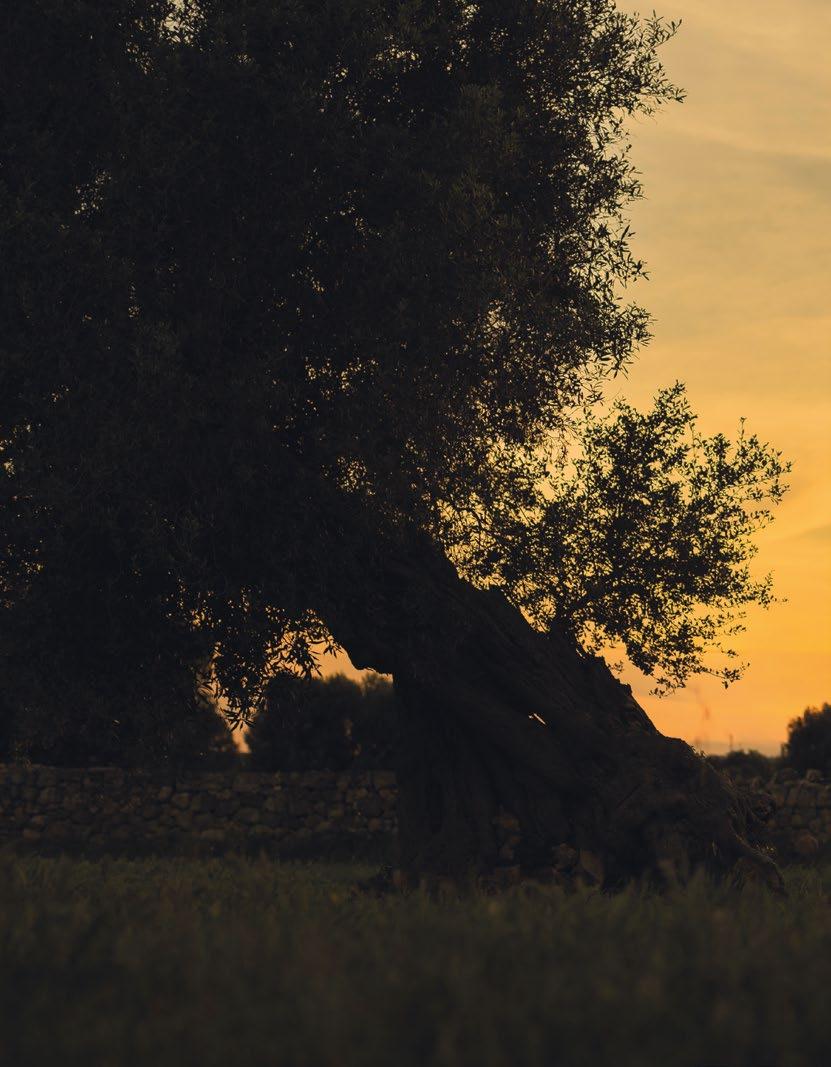 Aldo e Camilla Melpignano con le loro figlie Emma e Maria.
Aldo e Camilla Melpignano con le loro figlie Emma e Maria.
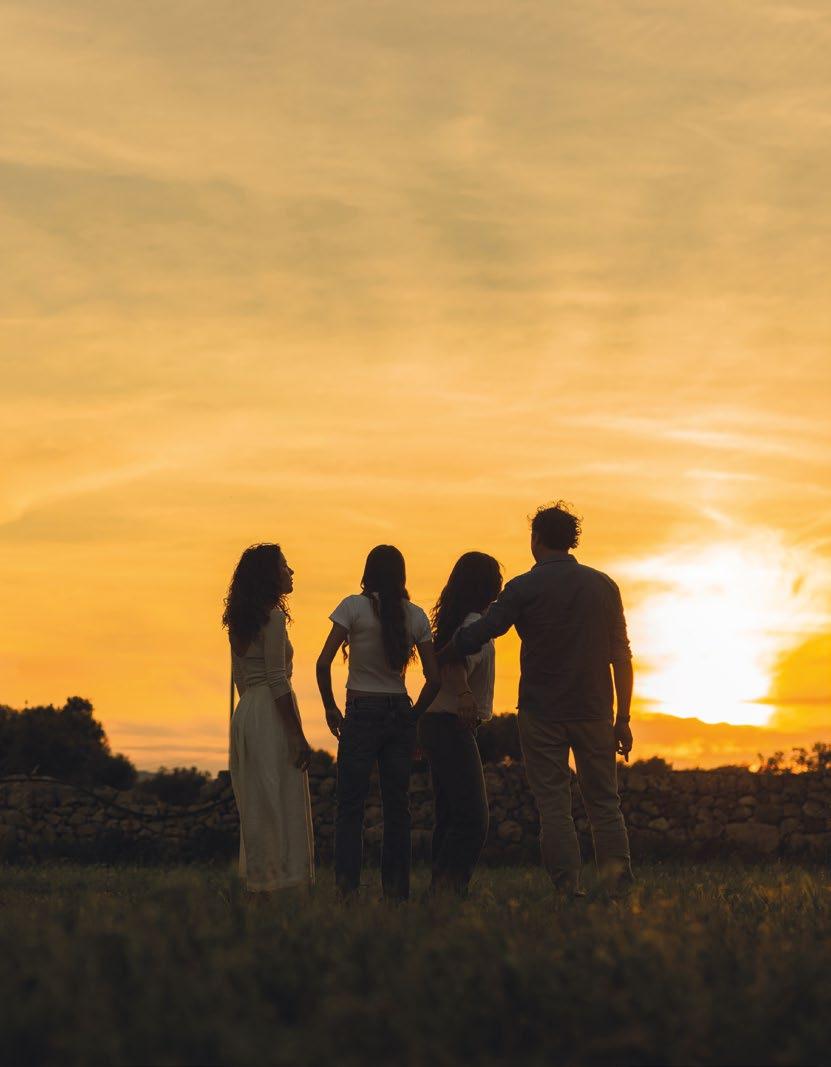
¬ Raffaele Panizza
UNA STORIA DI FAMIGLIA, GLI AMICI, LE RADICI
E UN PO’ DI SANA DISOBBEDIENZA ALLE REGOLE.
È L’OSPITALITÀ IN STILE MELPIGNANO
A story of family, friends, roots and a little healthy rule-breaking: this is hospitality in Melpignano style
L’ospitalità è la forma più dolce di follia. Uno slancio in cui si prende il cuore, lo si impacchetta con un nastrino e lo si consegna all’altro, che lo ripone nel suo scrigno e può farne ciò che vuole. Può manifestarsi la mattina presto oppure al momento del dessert, quando una cameriera con gli occhi di attesa, tra le colonne bianche di un ristorante di Borgo Egnazia, si disinteressa soavemente di un rifiuto e con voce tuonante di femminilità dice «insisto». Servendo a tavola, tra cento deboli «no», un gelato al pistacchio sul quale verserà, «insisto…», una generosa lacrima di olio d’oliva.
Perché l’accoglienza, da queste parti, è una forma cortese e ostinata di disobbedienza. «In effetti, qualche licenza poetica sul cerimoniale a cinque stelle ce la prendiamo» dice Aldo Melpignano, che Borgo Egnazia l’ha costruito insieme ai genitori Sergio e Marisa e lo gestisce con la moglie Camilla Melpignano. Milanese. All’inizio scioccata e ora avvezza a questo mondo dove gli uomini sbraitano ma le donne decidono, fatto «di gentilezza e grazia». Incarnate da gesti e attitudini in contrasto con ciò che la vita sembra volerci insegnare: essere guardinghi, calcolare, dare per ricevere, rispettare tempi e gerarchie. E invece ecco: d’un tratto, senza essere dei santi, in nome dei valori e delle generazioni indomite, in Puglia si compie la sacra transustanziazione. L’anima diventa pane. Il sorriso diventa ancora una volta olio extravergine in cui disciogliere succo d’uva e intingere la mollica di grano arso. La memoria si apparecchia a tavola in abbondanza. L’ospitalità non ha antifurti: aprirsi, aprire, preparare senza sapere cosa sarà gradito e cosa no. È un progetto senza certezze, e per questo, per quanto mille volte tradita, non potrà mai essere delusa.
In Puglia ogni cosa sembra insegnartela. La terra rossa dei campi che rimane imperturbabilmente se stessa, ci sia pioggia o ci sia arsura, nutrita dai suoi sali minerali e indifferente alle mode e alle minacce dell’agricoltura irrispettosa che si pratica altrove. In tutta la Piana degli olivi secolari e fino al mare, all’ombra delle fronde trovano posto mille coltivazioni: le patate col loro fiore CONTINUA >
Hospitality is the kindest form of madness. You enthusiastically take your heart, wrap a ribbon around it and give it to someone else so they can take it for themselves and do what they want with it. It can be found in the morning or when it’s time for dessert among the white columns of a Borgo Egnazia restaurant and a waitress with expectant eyes takes no notice of a guest turning it down, saying “Oh no, I insist” in a voice dripping with feminine charm. Paying no heed to countless feeble protests, she’ll serve pistachio ice cream and – “I insist” – generously drizzle olive oil over it.
In this part of the world, hospitality is a polite, stubborn form of disobedience. “It’s fair to say we use a little poetic licence when it comes to five-star etiquette,” says Aldo Melpignano, who built Borgo Egnazia with his parents Sergio and Marisa, and now runs it with his wife Camilla Melpignano, who’s from Milan. She was astonished at first but now she’s grown accustomed to a place where the men might yell but the women make the decisions and “kindness and politeness” prevail. This is all embodied by deeds and behaviour that go against the lessons life seems to want to teach us: be cautious and calculating, give in order to receive, and stick to set times and hierarchies. We might not be saints, but as we act in the name of indomitable generations and values, a type of transubstantiation occurs in Puglia. Our souls take the form of bread. Smiles turn into extra virgin olive oil, waiting for grape juice to be poured into it and soft grano arso bread (made from toasted wheat) to be dipped in it. Tables are set with a multitude of memories. Hospitality means opening up and exposing yourself, with no safeguards: you prepare things without knowing what people will like and what they won’t. You can never know for sure how it’ll all go, so you might be let down endless times, but you can never really be disappointed.
This seems to be the lesson you can learn from every little thing. The red soil in the fields remains imperturbably unchanged through both rain and drought, nourished by its minerals and unconcerned by the fashions and threats of reckless agricultural methods employed elsewhere. Piana degli Olivi Secolari is a plain where age-old olive trees grow. All across it and down to the sea, numerous crops grow in the shade of their foliage:
>
«Quando c’era brutto tempo mi chiedeva: cosa si mangia se piove? E io lo sapevo già: la pasta dei panzerotti, senza lievito, col latte» – Mimina
“When the weather was bad, he’d ask: what should we eat when it rains? I knew the answer: panzerotti dough with milk and no yeast” – Mimina
Nella pagina a fianco in alto, Marisa Melpignano. In basso a sinistra, la cuoca Mimina al San Domenico Golf.
On the opposite page, top right, Marisa Melpignano. Bottom left, Mimina at San Domenico Golf.
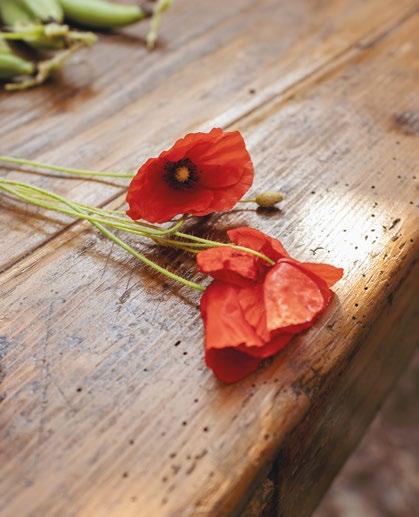
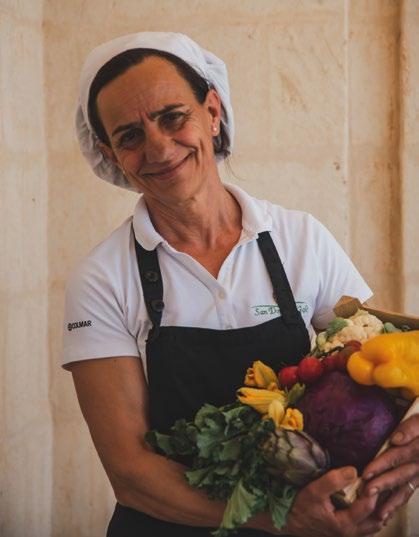
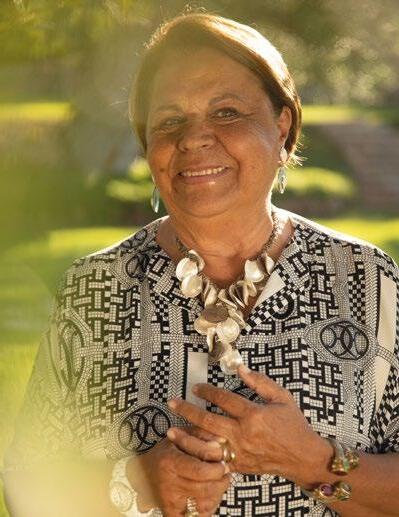
 ¬ Ph. Carlos Solito
¬ Ph. Carlos Solito
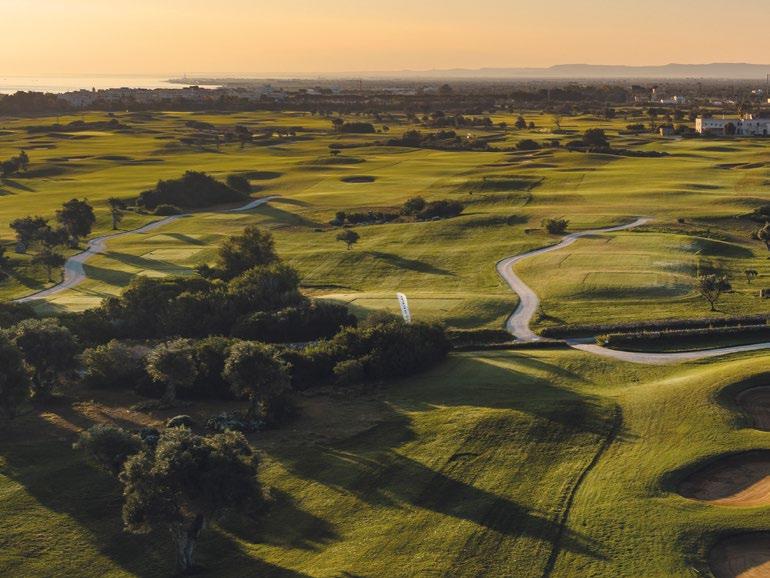
inatteso, i finocchi la cui pancia tonda spunta dal terreno, il sedano che profuma l’aria di pinzimonio e vellutata, il cavolo nero dalle foglie che sembrano mantelli di generale, la menta pronta per le frittate di pane e uova. Ogni cosa invita a cena l’altra. Ogni cosa è varietà. Sessantadue famiglie di olive. Novantadue cultivar autoctoni di uva. Solo di melanzane, ce ne sono dodici tipi. «E se le nespole cadono dall’albero, chi passa le raccoglie e le offre a un amico», dice Giuseppe Cupertino, molto più che sommelier a Borgo Egnazia. Un uomo che di vino pugliese sa tutto. Ma che non è ancora riuscito a convincere il padre Oronzo ad assaggiare una delle sue bottiglie pregiate: «Il tuo vino te lo bevi tu», gli risponde ogni volta, attaccato come una barbatella ai dieci ettari di uve minutulo e verdeca che coltiva,
imbottiglia, e regala a chi gli pare. «E non è un caso che il Negramaro sia il vino più richiesto al mondo, il più esportato: richiama uno stile di vita, un amore, una terra intera», dice Cupertino versando un calice di Chakra Rosso di Gioia del Colle.
Persino il maestrale che imperversa sulla costa è accolto come buonvento: i tronchi secolari sono tutti inclinati a sud, come a regalargli uno scivolo di fronde e lasciarlo soffiare in pace, e potenziarsi quasi. Quando tira fortissimo vengono innalzati subito gli aquiloni: lo scorso aprile, a guardarli in volo per il festival Zoo Skyline, sui prati di Savelletri si sono raccolte settantamila persone. E in questa follia dell’immaginazione sotto i suoi schiaffi è nato un campo da golf spettacolare, un links voluto dalla famiglia Melpignano
quando qui non c’era nulla, pochi ortaggi e il progetto (altrettanto matto) di realizzare un aeroporto sugli scogli, mentre oggi San Domenico Golf è parte dei circuiti internazionali e sfida la balistica dei giocatori come certi prati sulle Highlands scozzesi.
Rispetto alla Scozia, però, qui è tutto più aspro ma allo stesso tempo tutto più docile. E la consolazione dal vento arriva nelle ricette preparate da Mimina nel ristorante del Golf: gli ziti al forno con l’origano e la melanzana o l’introvabile sartù, un timballo di riso e polpette grandi come un cecio, mozzarella e parmigiano. «L’avvocato Melpignano amava il ragù cotto nel coccio, sui carboni ardenti. Così come nel coccio voleva il pollo, sfumato nel vin cotto che si ottiene dalla prima bollitura del mosto. E CONTINUA >

potatoes with their astonishing flowers, fennel with bulbous bellies protruding from the soil, celery filling the air with aromas that call to mind vegetable dips and soup, cavolo nero with leaves that look like generals’ cloaks, and mint for bread omelettes. Each is a culinary companion for another. Variety can be found in every one of them. There are 62 families of olives, 92 native grape cultivars and even 12 types of aubergines. “And when medlars fall from the tree, passers-by pick them up to give to friends,” says Giuseppe Cupertino, who is much more than just a sommelier at Borgo Egnazia. He knows everything about Puglian wine. However, he still hasn’t managed to convince his father Oronzo to drink one of the bottles from his superior selection. Oronzo makes his own wine from the Minutolo and Verdeca grapes he grows in his ten hectare-vineyards, then gives the
bottles out as presents. “It’s no surprise that Negroamaro’s the wine that’s most in demand worldwide: it calls to mind a lifestyle, love and its homeland as a whole,” says Cupertino as he pours a glass of Chakra Rosso from Gioia del Colle.
Even the Mistral that buffets the coast is welcomed: the trunks of the age-old trees all lean south, almost shaping themselves into leafy launchpads and letting it blow freely, or even get stronger. As soon as the wind gets up, people start flying kites: last April, 70,000 people flocked to the meadows near Savelletri to see them soaring during the Zoo Skyline festival. Where the wind whips the shore, a spectacular links golf course has been built thanks to the folly and fertile imagination of the Melpignano family. Where there was once nothing but a few vegetables growing and plans (that were just as
crazy) to build an airport by the seafront, you can now find San Domenico Golf. Part of international tours, it puts players to the test as much as courses in the Scottish Highlands.
Compared to Scotland, everything here’s more rugged yet more mellow at the same time. The wind will help work up an appetite for the comforting dishes made by Mimina at the golf course restaurant: baked ziti with oregano and aubergines or the elusive sartù, containing rice, mozzarella, Parmesan cheese and meatballs the size of chickpeas. “Mr Melpignano loved ragù cooked in an earthenware pot over hot coals. He also had his chicken cooked in an earthenware pot, in the vin cotto you get by boiling grape must once. When the weather was bad, he’d ask: what should you eat when it rains, Mimina? I knew the answer: CONTINUES >
«Quando il paniere va e viene, l’amicizia si mantiene». Da questa filosofia nasce l'usanza di donare cesti di ciliegie quando l’albero ne regala tante
"When the basket goes back and forth, friendship endures.” This saying in the local dialect refers to the way people give each other cherries when plenty grow on their trees
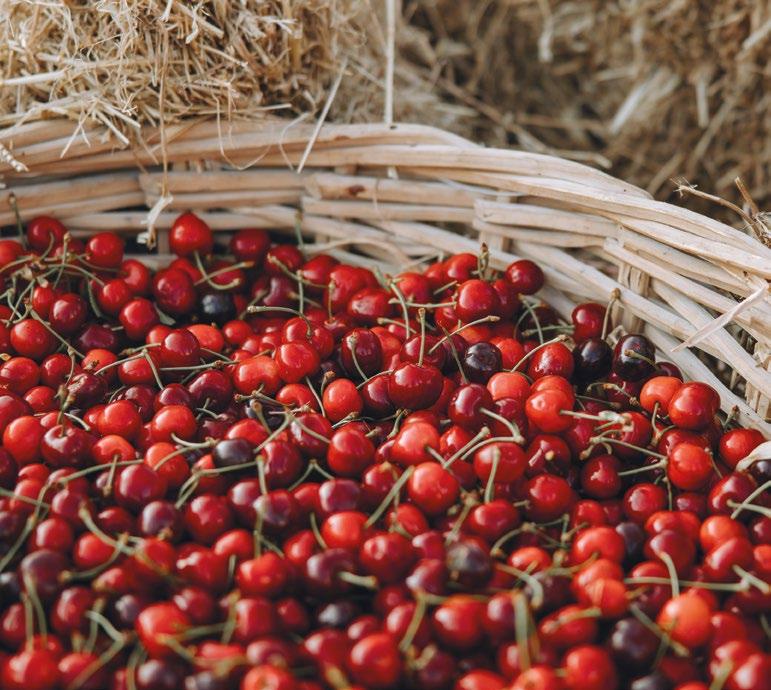
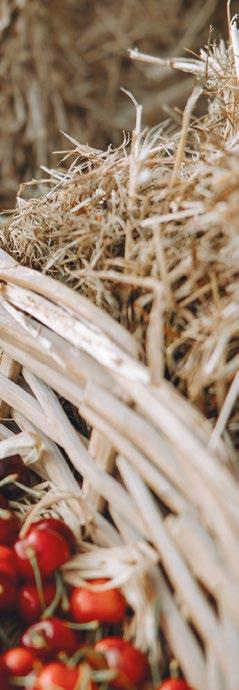
quando c’era brutto tempo mi diceva: cosa si mangia se piove, Mimina? E io lo sapevo già: la pasta dei panzerotti, senza lievito, col latte. Il pomodoro sì, ma soltanto i semi. E un po’ di parmigiano che si fonde».
Gesti imparati in famiglia e poi offerti a tutti. Come si fa con un papavero selvatico raccolto sul bordo del tratturo tra le campagne di Fasano: la corolla piegata all’ingiù per formare una gonnella, un filo nero di capelli per segnare il punto vita, gli stami a formare una collana e la stimma lasciata come testolina, per creare una bambolina che le bimbe regalavano alle amiche, in un gesto di amicizia mai dimenticato. Lo insegna Clara, che sa tramandare la magia delle cose ancestrali. Il lego per le costruzioni fatto col trifoglio tappezzante. I pupazzi costruiti con le pale carnose del fico d’India. I rosari coi noccioli d’olivo. «Quando il paniere va e viene, l’amicizia si mantiene», dice in dialetto, ricordando l’usanza di donare cesti di ciliegie quando l’albero ne regala tante. Nella sua Alberobello lavora per la memoria anche Mimmo, guida e oste e local friend di Borgo Egnazia, che ha trasformato uno dei suoi trulli in uno scrigno del passato: «Nelle campagne si rifugiavano gli sfollati dalle persecuzioni, e nei trulli abbandonati trovavano riparo i militari stanchi», dice, mostrando gli accendini americani e le pomate tedesche per i dolori, che ha trovato nei pozzi. «Qui ormai arrivano due milioni di visitatori l’anno, ma come dico io, essere carini coi turisti è fin troppo facile. È quando non hai nulla, e ugualmente dai, che il gesto ha davvero valore. E noi, con le braccia aperte, siamo sempre stati».
panzerotti dough with milk but no yeast. Tomatoes were OK, but only the seeds. And a little melted Parmesan.”
We learn these things at home and then share them with everyone. For example, when you pick a wild poppy growing by a tratturo (sheep track) in the Fasano countryside, you can make a doll by folding the petals down to make a skirt, wrapping a little black hair around the waist, shaping the stamens into a necklace and leaving the stigma as a head. Girls used to give them to each other, in unforgettable shows of friendship. It’s one of the things taught by Clara, who helps to pass down magical ancestral marvels. Clover can be used to make building blocks. The fleshy pads of prickly pears can be made into dolls. You can create rosaries with olive stones. “When the basket goes back and forth, friendship endures”, is a saying in the local dialect referring to the way people give each other cherries when plenty grow on their trees. Mimmo also keeps memories alive in his home town of Alberobello. A guide, host and local friend of Borgo Egnazia, he’s turned one of his trulli into a historical treasure trove: “Displaced people fleeing persecution sought refuge in the countryside and tired troops found shelter in abandoned trulli,” he says, showing American lighters and German pain-relieving ointments he’s found in wells. “We get two million visitors a year here now, but I always say there’s nothing easier than being nice to tourists. It’s when you have nothing but you still give that it really means something. And we’ve always been here with open arms.”
Around this tree, a symbol of peace and of Puglia, with its centuries-old and even millennia-old specimens, rituals, stories, and handmade objects have created with patience and passion
L’ulivo mi ricorda mio padre. Il senso di pace e libertà che provavo quando raccoglievamo insieme le olive è indelebile. Ogni anno, agli inizi di novembre, gli chiedevo: «Babbo, quando iniziamo la raccolta?» «Qualche altro giorno ancora, e si possono raccogliere», rispondeva.
E al momento giusto, stendevamo le reti sotto gli alberi, appoggiavamo lunghe scale di legno alle fronde, e cominciavamo la raccolta a mano, che durava quindici giorni. Lui ed io, da soli. Per ore, ascoltavamo il suono delle olive che cadevano, colpendo i pioli e i rami sottostanti prima di raggiungere il terreno. Non fiatavamo, per non perdere neanche una nota di quella sinfonia.
La passione di mio padre per gli ulivi non si limitava alla raccolta ma continuava tutto l’anno. Con i noccioli infilava coroncine di rosario, bracciali, collane, tende per porte e finestre. Ogni anno, ne faceva almeno una che poi donava a parenti e amici. Lo guardavo con ammirazione mentre limava e assemblava i noccioli. Mi trasmetteva un profondo senso di pace. Una volta ho contato quanti ce ne fossero in una delle sue tende: erano 15.000.
«Ma Babbo chi ti dà tutta questa pazienza?»
«È una cosa bella che mi ha insegnato nonno Giuseppe quando ero piccolo! Mi rilassa».
Nonno sapeva fare tante cose con l’ulivo, dai cesti realizzati con i polloni ai cucchiai in legno che si usavano per mescolare la purea di fave. Ricordi e manufatti che conservo gelosamente.
Solo ora comprendo quanto tutto ciò sia in grado di trasmettere un profondo senso di pace. Ripetere i gesti, le tecniche e le lavorazioni che vedevo fare a mio padre mi riporta alle mie radici, e mi emoziono pensando a quanti secoli abbiano attraversato queste usanze, tramandate di generazione in generazione. Di padre in figlia.
Olive trees remind me of my father. The sense of peace and freedom I felt when we gathered the olives together is unforgettable. Each year in early November, I would ask him, "Dad, when do we start harvesting?"
"A few more days and they can be picked," he would reply.
And at the right time, we would spread the nets under the trees, lean tall wooden ladders against the branches, and begin the hand-harvesting that lasted fifteen days. Just the two of us. For hours, we would listen to the sound of the olives as they fell, striking the ladder rungs and branches below before reaching the ground. We didn’t utter a word, so as not to miss a note of that symphony.
My father’s passion for olives was not limited to harvesting but continued throughout the year. With the pits, he made rosary crowns, bracelets, necklaces, and curtains for doors and windows. Every year he made at least one, which he then gave away to relatives and friends. I watched him with admiration as he filed and assembled the pits. He conveyed a deep sense of peace. Once, I counted how many there were in one of his curtains: there were 15,000.
“But Dad, where did you get all this patience from?”
“It's a beautiful thing that Grandpa Giuseppe taught me when I was a child! It's relaxing.”
Grandpa knew how to do many things with the olive tree, from baskets made from shoots to wooden spoons used to stir fava bean puree. Memories and artifacts that I jealously save.
Only now do I understand how much all this can convey a deep sense of peace. Repeating the gestures, techniques, and processes that I saw my father perform brings me back to my roots and moves me, thinking of how many centuries these customs have been passed down from generation to generation. From father to daughter.

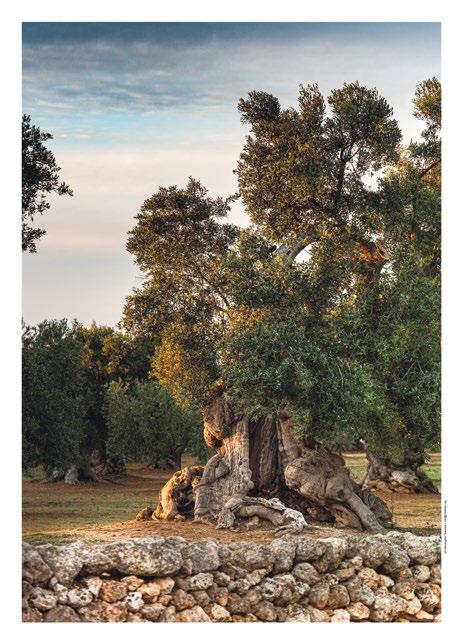
Old Memories Die Hard
¬ Sara MagroAt Borgo Egnazia, a cultural association has been established that revives and breathes new life into ancient arts, bringing them into the present
Eh già, le tradizioni. A parole ci teniamo tutti, ma poi le contingenze, la quotidianità, la fretta ce le fanno spesso tralasciare. E ci dispiace. Quasi a tutti dispiace, perché nei confronti del passato e di quel che si faceva vige sempre una certa nostalgia, un desiderio di trattenerle e mantenerle. Conserviamo una coperta della nonna in un cassetto, le lettere d’amore, il suo abito da sposa ancora piegato nella scatola originale, con le scritte sbiadite. E ogni tanto tiriamo fuori quei cimeli, li raccontiamo e poi riponiamo tutto dov’era. Ma la tradizione non si può mettere al museo, bisogna farla vivere. Ci vuole un nuovo pensiero, un nuovo vocabolario e una nuova sede. Da queste riflessioni, nel 2023, è nata Clara, l’associazione di Borgo Egnazia che recupera e riporta in vita le arti antiche.
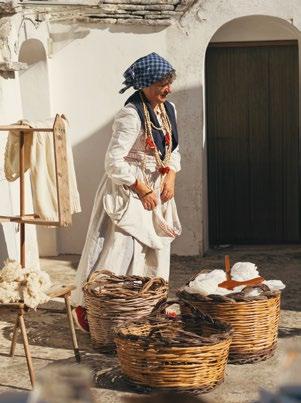
Ah, traditions. We all say we care about them, but then circumstances, everyday life, and haste often make us overlook them. And we regret it. Almost everyone regrets it, because there is always a certain nostalgia for the past and what was done, a desire to hold on to and keep the traditions alive. We keep a grandmother's blanket in a drawer, love letters, her wedding dress still folded in the original box with faded notes. And occasionally we take out these relics, talk about them, and then put everything back where it was. But tradition cannot be kept in a museum; it must be brought to life. It takes new thinking, a new vocabulary, and a new home. These considerations led in 2023 to the birth of Clara, the association of Borgo Egnazia that recovers and revives ancient arts.
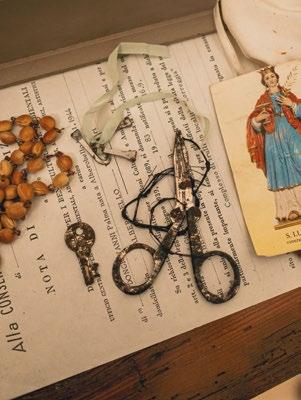
Le radici per Borgo Egnazia coincidono con le fondamenta stesse della sua struttura. Non c’è pietra o idea che non sia stata ispirata dalla storia scritta sui libri o raccontata. Le case, le corti, i colori, le vestine, la cucina. Il borgo è cresciuto insieme alle sue feste, dove si insegue il profumo delle bombette, si fotografa il cestaio che intreccia polloni d’ulivo, si balla insieme ai musicisti come se si fosse cresciuti con la pizzica nel sangue. Ecco in quel momento, per una magia intangibile, diventiamo tutti pugliesi.
Non basta più esporsi davanti al forestiero o ai giovani con il proprio fardello di storia, bisogna far breccia nel presente. Come l’upcycling innovativo delle sorelle Canfora che trasformano vecchi corredi in splendidi vestiti di pizzo. O come fanno gli artigiani quando infilano noccioli di ulivo o legumi secchi per fare collane da portare con l’orgoglio di un gioiello prezioso. Le tradizioni vivono di condivisione, piacere e stupore quotidiano. Si devono respirare nell’aria, toccare sui muri, portare come stemmi di un casato nobile. Ma devono fare innamorare e ingolosire, come un tarallo friabile che oggi può avere persino ingredienti migliori di una volta. Il nome non cambia, la ricetta nemmeno, ma corrisponde al presente, si addenta e non si evoca. Difficile dimenticare il sapore di un panzerotto croccante e filante. Quel panetto morbido caldo come un ventre materno ha il potere di insinuarsi nella memoria e diventare l’oggetto di una caccia al tesoro mentale finché non lo si ritrova. Forse per questo la Puglia è diventata una meta dove andare ma soprattutto dove tutti vogliono tornare.
associazioneclara.org
I bauli delle nonne custodiscono i tesori più preziosi.
Grandmothers' trunks hide the most precious treasures.
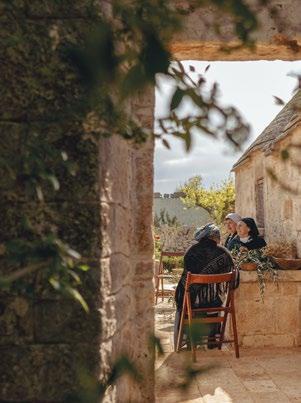
The roots for Borgo Egnazia coincide with the very foundations of its structure. There is not a stone or an idea that was not inspired by the history written in books or passed down orally. The houses, the courtyards, the colours, the clothing, the cuisine. The village has grown together with its festivals where you can follow the scent of bombette - a typical Puglian meat dish -, photograph the basket weaver intertwining olive shoots, dance together with musicians as if you grew up with the pizzica in your blood. Here, in that moment, by some intangible magic, we all become Puglians.
It's no longer enough to present ourselves to foreigners or the young with our own history; we must break into the present. Like the innovative upcycling of the Canfora sisters who transform old linens into beautiful lace dresses. Or as artisans do when they string olive pits or dried legumes to make necklaces worn as proudly as precious jewels. Traditions thrive on sharing, pleasure, and everyday wonder. They must be breathed in the air, touched on the walls, worn like the crests of a noble house. But they must also enchant and tempt like a crumbly tarallo that today might even have better ingredients than before. The name doesn't change, and neither does the recipe, but a tarallo adapts to the present, is savoured, not just evoked. It’s hard to forget the taste of a crispy, melty panzerotto. That soft, warm dough, like a maternal belly, has the power to seep into your memory and become the object of a mental treasure hunt until it is found again. Perhaps that's why Puglia has become a destination not just to visit, but a place everyone wants to return to.
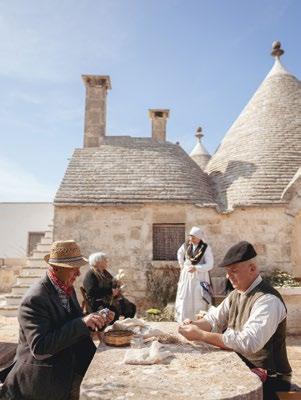
A OGNI MANCIATA DI CHILOMETRI
The story, words and pictures of a universally different language that changes every few kilometres
I dialetti, ed è doveroso l’uso del plurale, sono un patrimonio preziosissimo della Puglia e dell’Italia intera, riconosciuta come la nazione europea dove se ne contano di più. Analizzando i dialetti pugliesi, emergono alcune peculiarità fonetiche che, tra un sorriso e una risata, generano legittime domande. E qui proviamo a dare qualche risposta con l’autorevole aiuto del professore Marcello Aprile, ordinario di Linguistica italiana all’Università del Salento, esperto anche di dialettologia e minoranze linguistiche etniche e religiose.
È tutta una questione di aree ed è utile individuarle tracciando una linea immaginaria che passa poco sopra la città di Brindisi, attraversando Oria e Manduria. Possiamo subito distinguere il dialetto pugliese, convenzionalmente citato come «quello del Nord», da quello salentino. E qui si chiama in causa la ripartizione territoriale del Regno di Napoli: la Terra d’Otranto a Sud, la Terra di Bari a Nord, la Capitanata e poi il Gargano ancora più su. Che le dominazioni abbiano influito notevolmente sui dialetti pare un fatto scontato.
Su una mappa proviamo a individuare le aree accomunate da alcune peculiarità dialettali. Possiamo farlo, ma è pura convenzione, perché la realtà è molto più complessa e articolata: ogni singolo paese, se non addirittura frazione, ha un proprio dialetto con innumerevoli caratteristiche che lo rendono unico. È come se i nove chilometri che dividono, per esempio, Oria da Latiano fossero un viaggio compiuto dalle parole, che arrivano a destinazione vestite di nuovi suoni e a volte anche di inediti significati. Ogni centro italiano ha
CONTINUA >
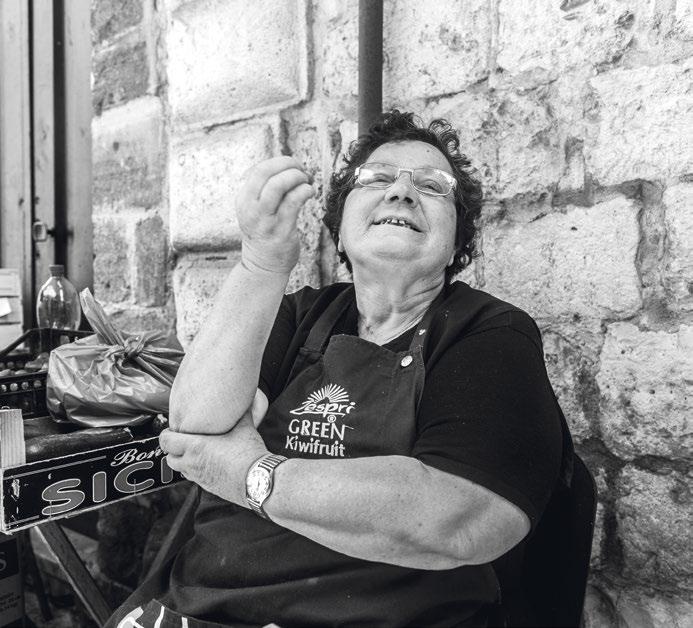
Dialects – and use of the plural form is essential here – are an invaluable part of the heritage of Puglia and the whole of Italy, which is acknowledged to have more of them than any other European country. Analysis of Puglian dialects reveals a number of phonetic peculiarities that are not only amusing in some cases, but also raise interesting questions. Below, we’ll try to answer some of them with the authoritative help of Marcello Aprile, full professor of Italian Linguistics at the University of Salento, who is also an expert on dialectology and ethnic and religious linguistic minorities.
It’s all a matter of areas and it can be useful to mark them out by drawing an imaginary line running just above Brindisi, through Oria and Manduria. The first thing we can do is distinguish between the Puglian dialect – conventionally referred to as “the dialect of the North” – and the Salento dialect. It’s important to note here how the Kingdom of Naples was divided: Terra d’Otranto in the South, Terra di Bari in the North, Capitanata and then above that Gargano. It seems clear that the divisions by the rulers had a significant impact on the dialects.
On a map, we could try to pick out areas that share certain dialectal peculiarities. However, it would be a purely conventional exercise because things are actually much more complex and intricate: every single village – or even hamlet – has its own dialect, with countless characteristics that make it unique. For example, it’s as if the words themselves go on a journey over the 9 km between Oria and Latiano. When they arrive, they have new sounds and sometimes even brand new meanings. Every village, town and city in Italy has a dialect that varies slightly from that of its neighbours, with CONTINUES >
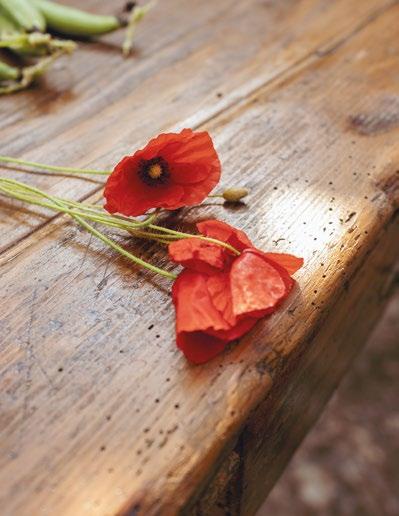

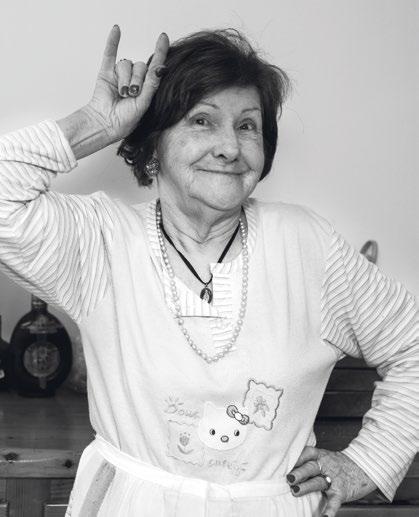

Il dialetto non è una storpiatura dell’italiano, ma un'evoluzione del latino parlato in una certa zona
Dialects are not mangled forms of Italian: they actually evolved from the Latin that was once spoken in different areas of the country
Ogni pugliese sa esprimere un ricco vocabolario dialettale in un solo gesto.
Every Puglian is capable of expressing a rich array of dialectal terms with a single gesture.
un dialetto leggermente diverso da quello dei vicini, per più nitide o impercettibili sfumature.
Si cade spesso nell’errore di pensare che il dialetto sia una storpiatura dell’italiano, ma il professor Aprile spiega come in realtà sia un’evoluzione del latino, parlato un tempo nelle diverse zone. Le origini del dialetto milanese andranno ricercate nel latino parlato in Lombardia duemila anni fa, così come il dialetto di Ancona sarà in relazione al latino parlato nelle Marche… e via discorrendo, per ogni città o paese. Anche il fiorentino nasce come evoluzione del latino con cui si conversava a Firenze, per poi diventare la nostra lingua, a seguito di fenomeni politici e culturali, tra cui in primis l’unificazione italiana.
Strettamente legata ai dialetti è la tematica delle minoranze linguistiche, tanto diverse eppure radicalmente affini al vernacolo. All’argomento, il professore Aprile riserva il comprensibile entusiasmo di chi affonda le proprie radici familiari nella comunità grika di Calimera, capace di evocare storie di popoli lontani. Emblema di un’atavica multiculturalità, la tutela delle minoranze linguistiche presenti sul territorio italiano è, va ricordato, prevista all’articolo 6 della nostra Costituzione.
Cotanto riconoscimento, in Puglia, trova espressione nel programma straordinario Matria. Le lingue di ieri, di oggi, di domani, dedicato alla tutela e alla valorizzazione delle
some differences that are clear and others that are barely perceptible.
People often make the mistake of thinking that dialects are mangled forms of Italian, but Professor Aprile explains that they actually evolved from the Latin that was once spoken in different areas. The origins of the Milanese dialect can be found in the Latin that was spoken in Lombardy 2000 years ago. The same applies to the dialect of Ancona and the Latin spoken in the Marche and so on, for every city, town and village. Italian itself comes from Florentine, which evolved from the Latin spoken in Florence and then became the national language due to various political and cultural factors, first and foremost the unification of Italy.
There are close ties between dialects and linguistic minorities, which are so different yet fundamentally akin to the vernacular. It’s a topic about which Professor Aprile is understandably enthusiastic, given his family’s roots in the Griko community of Calimera, which conjures up stories of distant peoples. As emblems of atavistic multiculturalism, it’s worth noting that the linguistic minorities in Italy are protected by Article 6 of the Italian Constitution.
In Puglia, this protection takes concrete form in a special initiative called ‘Matria. Le lingue di ieri, di oggi, di domani’, (Motherland: the languages of yesterday, today and tomorrow), which safeguards and promotes the area’s
> CONTINUES >

In un attimo ci si ritrova immersi in un codice linguistico indipendente e unico, dove le mani che si muovono servono per spiegare una parola o un’espressione
You can suddenly find yourself immersed in an independent, unique linguistic code, with hand movements being used to explain words or expressions
tre minoranze storico-linguistiche del territorio: la francoprovenzale, l’arbëreshë e la grika.
Territorialità, tono di voce, espressioni e cadenza sono caratteristiche identitarie dei nostri dialetti, tanto quanto, però, la gestualità, che merita un ulteriore approfondimento.
Parole e gesti sono interconnessi tra loro. La gestualità accompagna il linguaggio parlato, arrivando talvolta a sostituirlo, scandisce il ritmo di una conversazione e dà enfasi anche al non detto. Il movimento delle mani a corollario di un discorso è strumento proprio di innumerevoli culture, che curiosamente prescinde dalla lingua o l’età dei soggetti. In Puglia, per esperienza personale, è fortemente radicato l’uso dei gesti a corredo del linguaggio, una tendenza che diventa imprescindibile quando per comunicare si utilizza il dialetto.
three historical linguistic minorities: Franco-Provençal, Arbëreshë and Griko.
As well as territoriality, tone of voice, expressions and cadence, another equally important identifying feature of our dialects that deserves to be examined in more detail is use of gestures.
Words and gestures are interlinked. Gestures accompany spoken language and sometimes even replace it, while also setting the tempo of conversations and emphasising things, including some that go unsaid. Movement of the hands to complement speech is a tool used by countless cultures. Interestingly, this is true regardless of the age and the language of the speaker. From personal experience, I know that use of gestures alongside words is well established in Puglia. It’s essential when people talk in dialect.
There’s a dialect in every village and a gesture for every phrase in every dialect. You can suddenly find yourself immersed in an independent, unique linguistic code, with hand movements being used to explain words or expressions not only to foreigners from distant
Un dialetto per ogni paese, un gesto per ogni frase di quel dialetto. In un attimo ci si ritrova immersi in un codice linguistico indipendente e unico, dove le mani che CONTINUA > CONTINUES >

Dove le parole non arrivano, si ascolta con gli occhi.
When words are not enough, you listen with your eyes.
si muovono servono per spiegare una parola o un’espressione, non solo allo straniero che arriva da luoghi lontani, ma anche al conterraneo che vive in una provincia poco distante. Come le parole così i gesti sono convenzionalmente riconosciuti e passeggiando per le vie di Bari vecchia, come per quelle di Brindisi, non si sarà colti impreparati davanti a una mano chiusa a cono, che ondeggia verso l’alto, in risposta a uno sguardo furtivo.
Il dialetto ha mille sfumature, caratteristiche e inclinazioni, ha una sua autonomia e una storia affascinante, che non si limita all’indagine di questioni meramente geografiche, ma coinvolge aspetti legati all’essere umano e alla sua identità. Scoprire un dialetto dà la possibilità di valorizzare aspetti culturali importanti, imparare a parlarlo offre l’opportunità di preservarli.
lands, but also to compatriots from a different province just a short distance away. Like words, gestures are conventionally recognised, so when people are strolling around the streets of old Bari or Brindisi, they won’t be caught unprepared if they see a hand closed into a cone shape and swaying upwards in response to a furtive glance.
Dialects have countless nuances, characteristics and inclinations. They are independent and they have fascinating stories, which go beyond research into purely geographical matters and involve aspects associated with human beings and their identities. Discovering a dialect opens up the possibility of promoting important facets of culture. Learning to speak it presents the opportunity to preserve them.
Le foto in bianco e nero di questo reportage sono tratte da "Capissce a mmè?", un progetto sulla gestualità barese di Anna Simi. Dopo il debutto nel 2014 con una mostra a Bari, nel 2017, il suo racconto è diventato libro, ora tradotto anche in inglese (Claudio Grenzi Editore).
«Le tradizioni e la saggezza popolare sono un patrimonio nascosto e custodito tra i vicoli di Bari Vecchia, in passato zona off limit, dove atteggiamenti e gesti antichi sono sopravvissuti grazie ai racconti tramandati dai familiari», spiega la fotografa. «Il vero barese può comunicare senza parole, ed è questo che mi ha spinto a studiare i loro gesti, scoprendo storie e sfumature inaspettate». Con le sue foto, Simi ha documentato un vocabolario dialettale alternativo fatto di manualità e mimica facciale, compiendo una straordinaria indagine culturale ed etimologica approfondita sulla Bari popolare.

The black and white photographs featured in this article are from Capissce a mmè?, a project on hand gestures by Anna Simi. Her visual narration made its debut in 2014 with an exhibition in Bari and was published as a book in 2017, translated into English (Claudio Grenzi Editore).
“Traditions and folk wisdom are a heritage that has been hidden and safeguarded for years in the alleys of a once off-limits Bari Vecchia, the Old Town, where ancient mannerisms and gestures have survived through stories passed down by family members,” Simi explains. “Baresi” can communicate without words, and that’s what led me to explore their use of gestures, uncovering unexpected stories and nuances.” With her photographs, Simi has documented an alternative dialectal vocabulary made up of hand gestures and facial expressions, carrying out an extraordinary cultural and etymological investigation of the people of Bari.

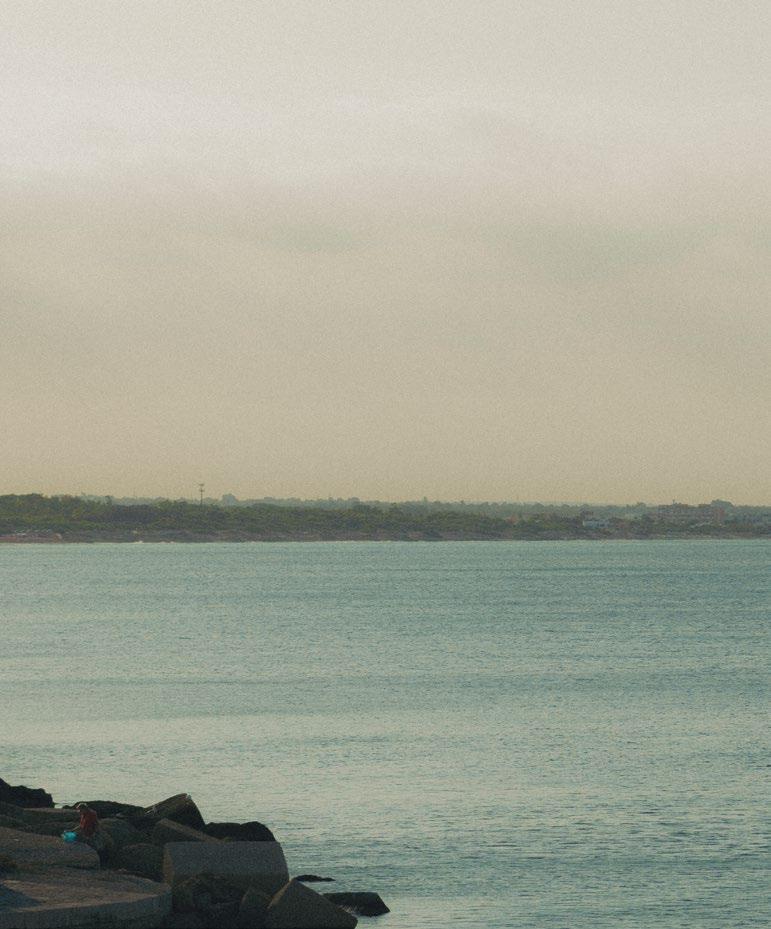
The Lady with the Drum
¬ Alessia Bologna
C'ERA UNA VOLTA UNA DAMA CON IL TAMBURO... QUESTA LEGGENDA ANTICHISSIMA SI RACCONTA ANCORA COME SIMBOLO DI ETERNO AMORE
Once upon a time there was a lady with a drum... This ancient legend is still told as a symbol of eternal love
Quando gli spagnoli giunsero in Puglia, affidarono il feudo di Monopoli a uno dei loro più valorosi condottieri. L’uomo, di bell'aspetto e fiero, passeggiava tra vivaci vicoli, quando incontrò una giovane monopolitana che conquistò il suo cuore con un solo sguardo. I due, travolti dalla passione, si sposarono e fecero del maestoso Castello di Carlo V la loro dimora, un nido d'amore sospeso tra cielo e mare.
Il condottiero trascorreva molto tempo navigando lontano dalle rive e, nelle giornate burrascose, la moglie era solita suonare un tamburo che, con il suo richiamo, gli indicava la via di casa, assicurandone l’approdo.
Sembrava un giorno come tanti quando, come di consueto, il condottiero salpò. Aveva lasciato la costa da diversi giorni, quando la dama iniziò a suonare il tamburo, che con il suo serrato ritmo, invitava la nave a far ritorno. Le stanche mani della giovane continuarono a percuotere a lungo, alimentate dalla speranza di poter riabbracciare il marito.
Oggi, nel castello che fu un tempo dimora degli sposi, il suono del tamburo riecheggia nelle giornate di tempesta. È un richiamo per le navi che continua a risuonare, guidando le imbarcazioni in difficoltà verso il porto sicuro, un'eco di un amore che sfida l'eternità.
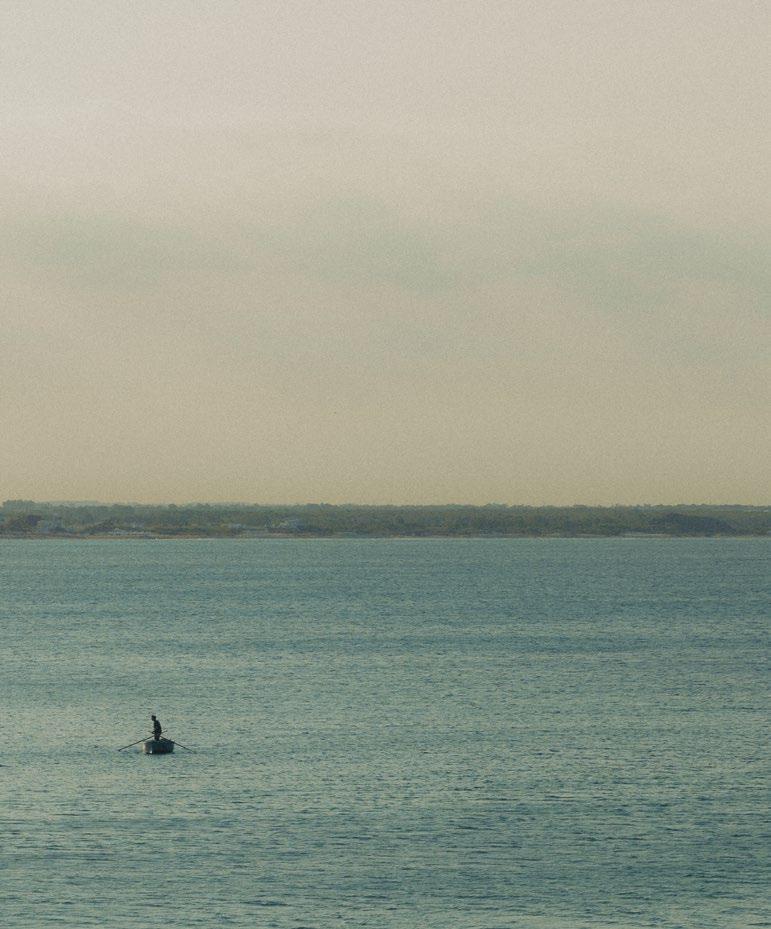
When the Spaniards arrived in Puglia, they entrusted the feud of Monopoli to one of their most valiant commanders. The proud, handsome man was walking through the lively alleys of the town when he met a young woman who captured his heart with a single glance. Overwhelmed by passion, the two married and made the majestic Castle of Charles V their home—a love nest suspended between sky and sea.
The commander spent much time sailing away from the shores, and on stormy days, his wife would play a drum whose call would guide him home, ensuring his safe landing.
It seemed like any other day when, as usual, the commander sailed out. He had been away from the coast for several days when the lady began to play the drum, its urgent rhythm beckoning the ship to return. The young woman's weary hands continued to beat for a long time, fuelled by the hope of embracing her husband again.
Today, in the castle that was once a home of lovers, the sound of the drum echoes on stormy days. It is a call for ships that continues to resonate, guiding vessels in distress towards a safe harbour, an echo of a love that transcends time.
This is No Dream
¬ Oronzo Rubino ¬ Ph. Giacomo PepeLA BASILICA DI SIPONTO RINASCE GRAZIE A UN’OPERA D’ARTE CONTEMPORANEA CHE REINTERPRETA L’ARCHEOLOGIA E PROPONE UN MODELLO INNOVATIVO DI RESTAURO CLASSICO
The Basilica di Siponto has been resurrected by a contemporary artwork that reinterprets archaeology and introduces an innovative model of classical restoration
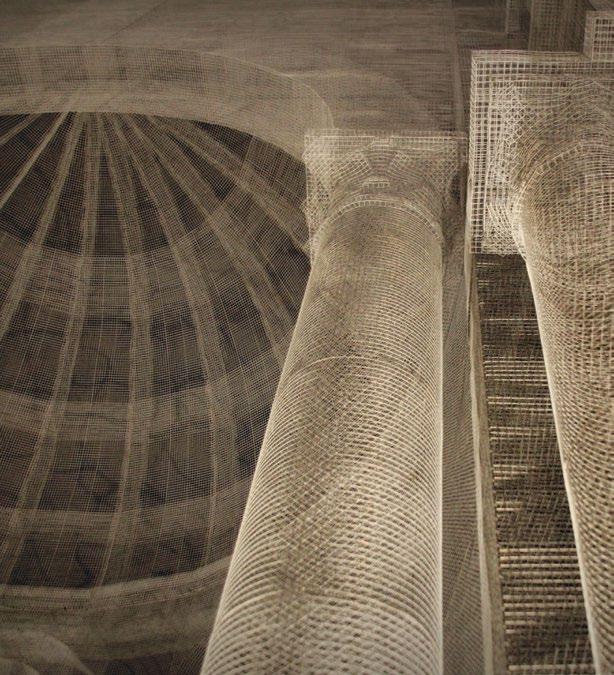

Da lontano sembra una proiezione in video-mapping creata con raggi laser e droni. Poi, avvicinandosi, ci si rende conto che non è realtà aumentata bensì un monumento maestoso e concreto. La Basilica di Siponto è lì davanti agli occhi, immagine tangibile di una chiesa paleocristiana di cui restano solo i ruderi. Un’opera emozionante dal titolo evocativo – Dove l’arte ricostruisce il tempo – realizzata nel 2016 da Edoardo Tresoldi all’interno del Parco archeologico di Siponto, piccola località vicina a Manfredonia che fino al XIII secolo era una delle più importanti diocesi pugliesi.
Sulle fondamenta della basilica, una superficie di 500 metri quadrati con abside al centro e mosaici sul pavimento, l’artista milanese ha montato una struttura alta 14 metri costituita da 4.500 metri di rete metallica, creando così un’impalcatura onirica nella quale i visitatori possono rivivere l’architettura del IV secolo, come se ancora esistesse. Un’innovativa rilettura dell’archeologia che unisce lo sviluppo del restauro classico e arte contemporanea.
Attraversare l’installazione lascia col fiato sospeso. La sensazione di meraviglia cresce al tramonto, soprattutto in estate, quando il cielo inizia a sfumarsi di rosa e arancione fino a diventare notte. In quel momento, si accendono i proiettori led sul pavimento, che mettono in evidenza la trasparenza tridimensionale dell’installazione e il contorno della basilica di Santa Maria Maggiore al suo fianco, una delle opere più importanti del romanico pugliese, ancora intatta nei suoi volumi essenziali. Impossibile non restarne catturati.
From afar, it may look like a video-mapping projection crafted with laser beams and drones. On closer inspection, it reveals itself not as augmented reality but as a majestic physical monument. The Basilica di Siponto stands before you, a tangible representation of an early Christian church of which only ruins remain. This awe-inspiring work of art, evocatively titled "Dove l’arte ricostruisce il tempo" (Where Art Rebuilds Time), was crafted in 2016 by Edoardo Tresoldi within the Archaeological Park of Siponto—a small town near Manfredonia that was one of Puglia’s most important dioceses until the 13th century.
On the basilica's foundations, covering an area of 500 square metres with a central apse and a mosaic floor, the Milanese artist erected a 14-metre-high structure made of 4,500 metres of wire mesh, creating a dreamlike scaffold where visitors can relive the fourth-century edifice as if it still stood. This innovative reinterpretation of archaeology melds the development of classical restoration with contemporary art.
Walking through the installation takes your breath away. The feeling of wonder intensifies at sunset, especially in summer, when the sky starts to blush pink and orange before nightfall. At that moment, LED projectors illuminate the floor, accentuating the installation's three-dimensional transparency and the outline of the adjacent Basilica of Santa Maria Maggiore—one of the most significant works of Puglian Romanesque architecture, still intact in its essential forms. The experience is truly captivating.
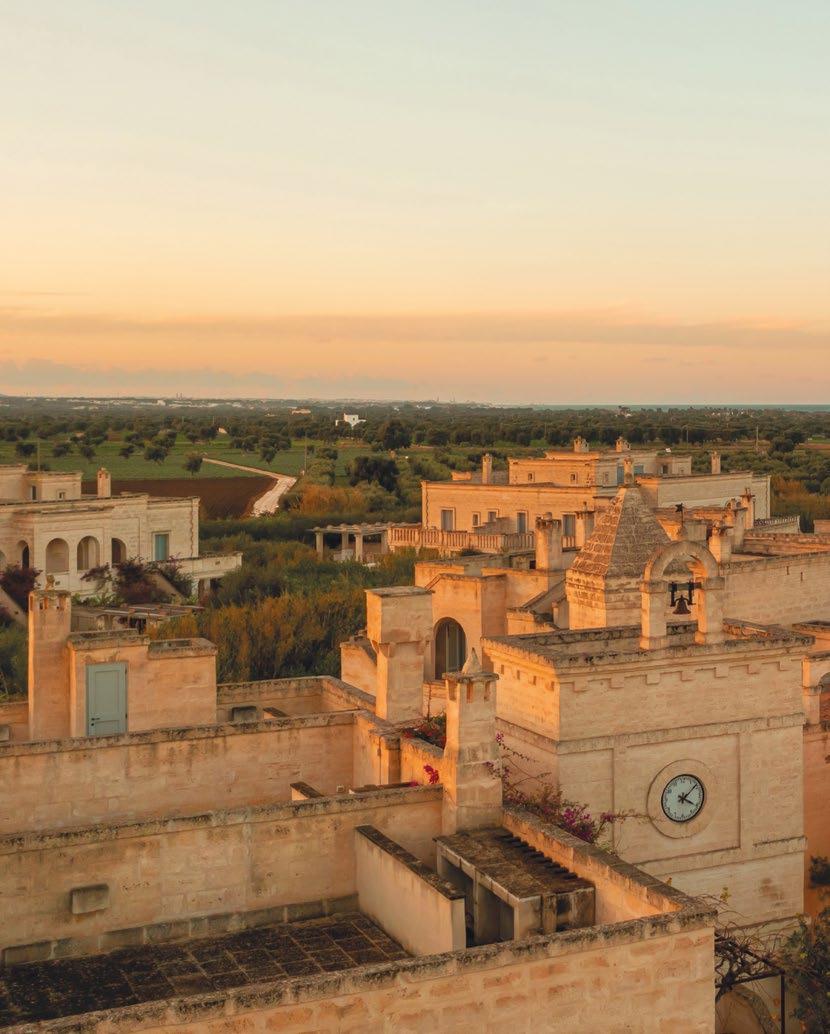
¬ Elena Luraghi ¬ Ph. Cosimo Rubino & Simone Valenzano
LA VITA RURALE, LE ARCHITETTURE COSTRUITE SUI BISOGNI DELLA QUOTIDIANITÀ, GLI INCONTRI E LE FESTE IN PIAZZA. ECCO COME È NATO UN PROGETTO INNOVATIVO E ORIGINALE GUARDANDO NEL PASSATO TRA MASSERIE, TRULLI E PICCOLI VILLAGGI
Rural life, architecture built to suit everyday needs, gatherings and parties in the piazza. An innovative, original project was inspired by a look back into the past, at masserie, trulli and small villages
A Borgo Egnazia, i muri in tufo
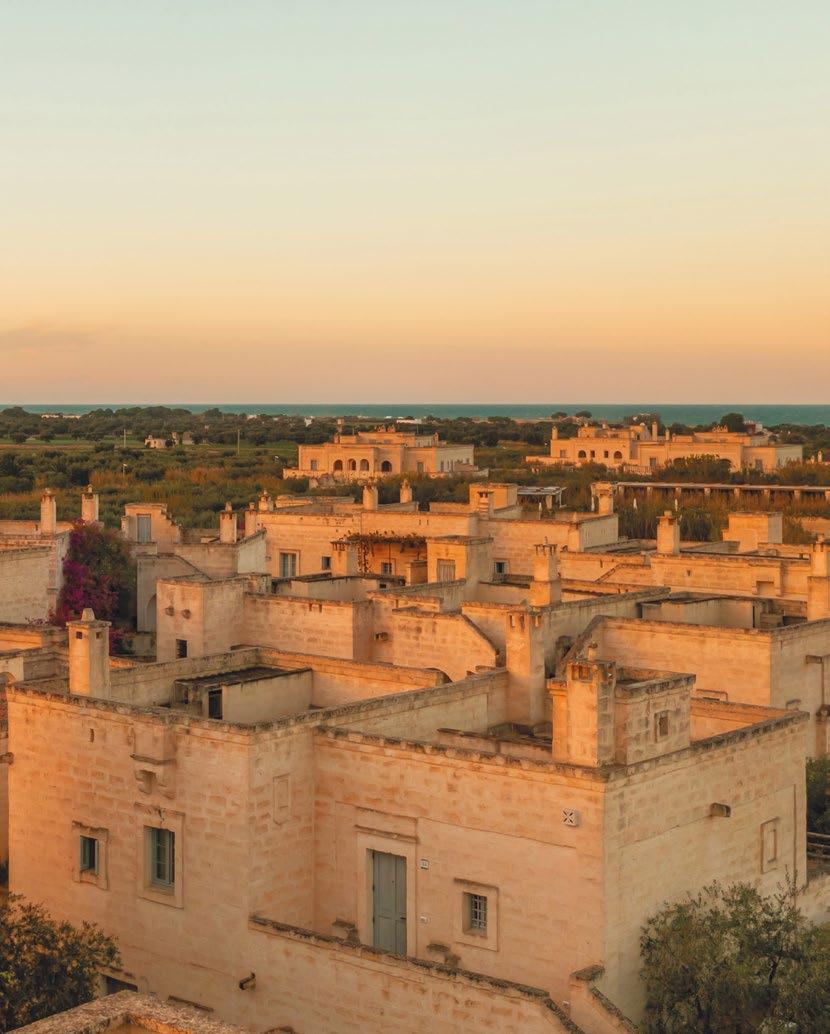
Borgo Egnazia, a place where pale stone walls meet the bright colours of the Puglian countryside.
chiaro risaltano sui colori accesi della campagna pugliese.Erano umili costruzioni rurali, i gioielli dell’architettura pugliese: una manciata di stanze vicino al fienile, il ricovero per gli animali, i depositi destinati al raccolto dei campi e i trappeti (i frantoi ipogei), cresciuti attorno alla villa nella quale viveva il proprietario terriero, secondo la regola un tempo diffusa della mezzadria.
Le masserie erano un mondo a sé, un sistema di comunità agricola che viveva in armonia con il clima, la luce, il sole, la terra: elementi fondamentali per lo sviluppo di quella magia architettonica composta da muri bianchi e cortili, porticati dalle volte in tufo o rivestite a calce, abbracciati da torri di avvistamento ed elementi difensivi realizzati a protezione dalle invasioni, soprattutto dopo gli attacchi turchi nella seconda metà del XV secolo.
Costruite con il tufo e la pietra calcarea, materiale facilmente reperibile nelle cave pugliesi, e sature di sole e di luce, le masserie affiancavano gli jazzi (i recinti in pietra a secco, ndr) agli spazi residenziali dalle geometrie elementari. Le proprietà più grandi potevano avere la cisterna per la raccolta dell’acqua e, a partire dal SetteOttocento, la chiesetta nella quale officiare messa alla domenica.
Al centro della tenuta, il cortile era allo stesso tempo aia per gli animali e spazio d’aggregazione sociale, in risposta al bisogno molto umano di vivere in comunità all’interno di un ambiente difeso e protetto. Qui si cuoceva il pane, si filava la lana, si ricamava, si macinavano lavoro e storie. E nelle sere d’estate i canti popolari della tradizione contadina si disperdevano in lontananza nella campagna, mescolandosi con il frinire dei grilli e delle cicale.
Alla vita rurale legata alla terra da coltivare si affiancava quella nel borgo di origine medievale: anche questo un mondo bianco, con le pareti delle case ammantate a calce e i vicoli stretti per proteggersi dal sole, arrotolati e attorcigliati attorno ad archi e scalinate protese verso il centro del paese, verso la piazza: un palcoscenico di vita, il luogo dove per secoli le persone hanno mescolato e condiviso storie private e tradizioni della comunità,
Humble rural buildings were the gems of Puglian architecture: a handful of rooms near the barn, a shelter for the animals, storehouses for the crops from the fields and trappeti (underground oil mills). All of this would take shape around the landowner’s manor house, under the once widespread sharecropping system.
Farms of this kind were known as masserie and they were a world of their own: a rural community living in harmony with the climate, light, sun and earth. These aspects played a key part in the development of enchanting architecture featuring white walls, courtyards and whitewashed or limestone vaulted porticoes, as well as watch towers and defensive works for protection against invasions, especially after Turkish attacks in the second half of the 15th century.
Bathed in light and sunshine, the masserie were built with the limestone that was easy to find in Puglian quarries. Dry stone walls known as jazzi stood alongside simply shaped homes. Some of the larger properties had cisterns for collecting water and – from the 18th and 19th centuries onwards – a small church for Sunday Mass.
The courtyard at the centre of each estate served as both a barnyard for the animals and a place for socialising, thus catering to the very human need to be part of a community in a defended, protected environment. It was a place where people baked bread, spun wool, embroidered, mulled over work and told stories. On summer evenings, the sound of traditional peasant folk songs drifted out over the countryside, blending with the chirps of crickets and cicadas.
As well as those who farmed the land in rural areas, there were people who lived in medieval villages: another white world, with whitewashed walls and narrow alleys to provide protection from the sun. They were wrapped around arches and steps stretching towards the piazza at the centre of the village: a stage in the theatre of life, where for centuries people gathered and shared private stories and community traditions, now remembered during celebrations in costume and folk festivals. No fewer than 13 of the most beautiful villages in Italy selected by the “Borghi Più Belli d’Italia” association are in Puglia. Trulli capital Alberobello CONTINUA >
Qui si cuoceva il pane, si filava la lana, si ricamava, si macinavano lavoro e storie
It was a place where people baked bread, spun wool, embroidered, mulled over work and told stories
Pagina accanto, scorci poetici di Borgo Egnazia: archi, camini, l’orologio in Piazza e, per spostarsi, le biciclette.
On the opposite page, poetic glimpses of Borgo Egnazia: arches, chimneys, the clock in the Piazza and bicycles to get around.
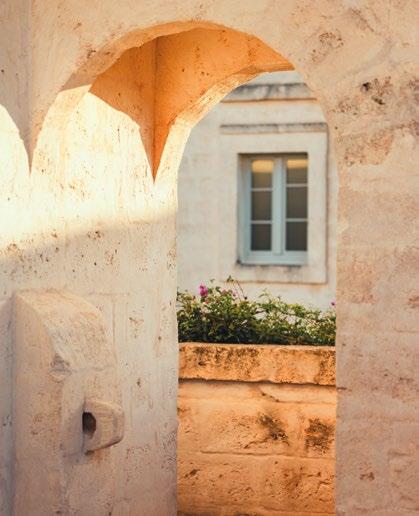
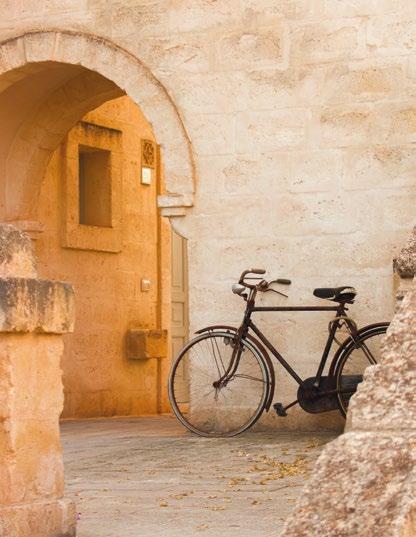
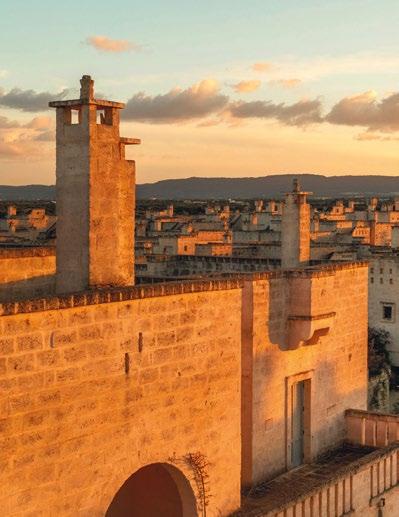

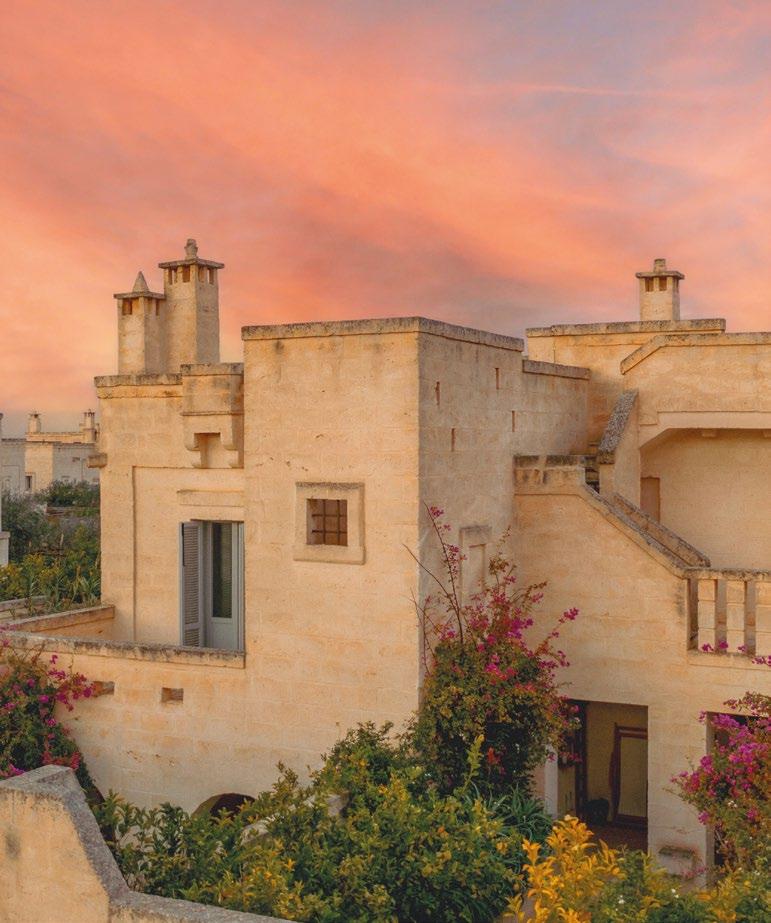

ricordate oggi da feste in costume e sagre popolari. Fra i borghi più belli d’Italia, ben tredici sono pugliesi, e Alberobello, la capitale dei trulli, nel 1996 è stata dichiarata sito Unesco. È il fascino della storia modellata sui bisogni di una comunità: le case dalla pianta rotonda sono in pietra calcarea, raccolta nei campi e aggregata senza malta, come avveniva per muri a secco di campagna; il tetto conico dipinto di bianco veniva spesso chiuso da un elemento decorativo esoterico, considerato un porta fortuna.
Che si tratti di borghi o masserie, quella Puglia contadina, simbolo del legame tra l’uomo e la terra, è diventata un modello da imitare per molti hotel immersi nella natura. A Borgo Egnazia, la famiglia Melpignano ha saputo osare e si è spinta molto oltre. Anziché riprodurre filologicamente una copia del passato, grazie alla regia magistrale di Pino Brescia, pugliese doc, ha creato dal nulla una realtà che non è né un hotel, né un borgo, né una masseria, ma tutte queste cose insieme. È grazie al frutto di una lunga ricerca se questo luogo pluripremiato riesce ad esprimere un bisogno di bellezza che affonda le radici nella tradizione più vera, senza cadere nei cliché e trasportandola nella contemporaneità.
Dove fino a non molti anni fa c’era solo un campo vuoto coltivato a ortaggi, lentamente hanno preso forma le tre anime del progetto di Borgo Egnazia. L’edificio principale chiamato La Corte – lo spazio dell’accoglienza, dove arrivano gli ospiti – è un chiaro omaggio alle masserie: un mondo di tufo raccolto attorno al grande atrio centrale, che accoglie la reception con i divani e i camini per riscaldarsi nelle giornate più fredde, esattamente come avveniva in campagna, quando i contadini portavano in uno spazio analogo
Ogni dettaglio è ispirato ai materiali, alle forme e ai colori di un tipico paese pugliese.
Every detail is inspired by the materials, shapes and colours of a typical Puglian village.
was named a Unesco World Heritage Site in 1996. It embodies fascinating history shaped around a community’s needs. The round houses were made of limestone found in the fields and put together without mortar, like dry stone walls in the countryside. The conical roofs were painted white and often sealed at the top with an esoteric decorative piece that was thought to bring good luck.
The villages and farms of rustic Puglia symbolised the bond between people and the land and established a model that inspired many hotels in natural surroundings. At Borgo Egnazia, the Melpignano family made the bold choice to take things to a whole new level. Instead of slavishly producing a carbon copy of the past, under the masterful supervision of born and bred Puglian Pino Brescia, out of nothing they created something that is not a hotel, a village or a masseria, but all of these things at the same time. It’s thanks to extensive research that this multi-award-winning place satisfies a need for beauty built on genuine traditions, adding a contemporary touch and steering clear of all clichés.
Where not many years ago there was nothing but an empty field with vegetables growing in it, the three cornerstones of Borgo Egnazia have slowly taken shape. Known as La Corte, the main building where guests are greeted upon their arrival clearly pays tribute to old countryside houses. An abundance of limestone lines a large central lobby containing a reception with sofas and fireplaces where guests can warm up on cold days, just like the farmers who would bring the day’s harvest into a similar space and rest after a hard day’s work. As in the rest of the Borgo, in La Corte an intimate atmosphere is created by soft lights hidden in stones and
il raccolto del giorno, e riposavano dopo una giornata di lavoro. Sempre lì, nella Corte (e in generale in tutto il Borgo), le luci nascoste nelle pietre e nelle caditoie – i piccoli balconi forati che nelle masserie servivano per versare olio bollente sul nemico in caso d’attacco – dispensano atmosfere intime e soffuse. Ma c’è di più: accanto a quegli spazi di pietra chiara si incrociano idealmente i quattro elementi, appena intuiti e filtrati dal design contemporaneo che arreda elegantemente gli spazi. L’aria qui viene interpretata come l’occasione di vivere una nuova esperienza, simboleggiata dalla barriera fisica dell’arco, oltre il quale le macchine non possono proseguire. La reception è la terra: ci sono sacchi con semi, noci, mandorle, limoni… Il grande albero centrale, con le pagine dei libri al posto delle foglie, simboleggia il fuoco perché lì filtra dall’esterno la luce solare. Infine, l’acqua: quella delle piscine collegate al bar e al primo dei ristoranti, sotto un porticato che ricorda quello delle masserie dove le donne potevano lavorare proteggendosi dal sole.
I dettagli della storia ritornano nelle novantadue Casette del Borgo, ispirato a quello dei contadini, con le mura spesse in tufo, i pavimenti in pietra locale e le finestre piccole, per proteggersi dal caldo in estate e trattenere il calore in inverno. Hanno tutte le camere al primo piano, diverse e mai troppo grandi, come vuole la tradizione pugliese. Attorno, vicoli volutamente non ordinati, di dimensioni e pendenze diverse, conducono alla Piazza, che nel passato era un luogo di festa e d’incontro. Gli ospiti di Borgo Egnazia vi si intrattengono con aperitivi, cene e feste all’aperto sotto alla torre dell’orologio (l’unico segnatempo della struttura), che nei villaggi del passato scandiva le ore del riposo e del lavoro, mentre qui batte con discrezione lo scorrere felice del tempo.
L’omaggio alle forme architettoniche della storia è presente anche nelle Case, ispirate questa volta non alle masserie o alle dimore rurali, ma alle ville di vacanza dei ricchi proprietari terrieri. Abbracciate da giardini, patii, terrazze in tufo, hanno interni classici ed eleganti. E sono pensate per fare vivere agli ospiti le atmosfere di una vera casa.
box-machicolations – small balconies with holes in the bottom through which boiling oil could be poured onto attacking enemies. In addition, alongside these light stone spaces, subtle nods to the four elements shine through in the sophisticated, contemporary interior design scheme. Air is interpreted as a chance to enjoy a new experience and symbolised by the physical barrier formed by the arch, beyond which cars cannot go. With its bags of seeds, walnuts, almonds, lemons and more, the reception represents earth. There are pages from books instead of leaves on the large tree in the centre, which filters sunlight from outside and is thus a symbol of fire. Finally, there’s water: in the pools by the bar and the first of the restaurants, under a portico like at a masseria, where women could seek shelter from the sunshine as they worked.
Yet more historical details can be found in the Borgo’s 92 Casette, which are inspired by peasants’ homes with thick limestone walls, local stone flooring and small windows to keep heat out in the summer and keep it in during the winter. All of the rooms are on the first floor. They’re all different and not too big, in keeping with Puglian tradition. There’s a deliberate lack of uniformity in the narrow streets – with varying gradients and sizes – leading to the Piazza, which was a place for gatherings and celebrations in the past. Borgo Egnazia’s guests go there to enjoy outdoor aperitivi, dinners and parties under the clock tower (the only timekeeper in the whole place). In villages in the past, structures like this told people when to work and rest. Here, it discreetly marks time passing happily.
Tributes to historic architecture can also be found in the Case. Rather than masserie or rural dwellings, they’re inspired by the holiday villas of rich landowners. Surrounded by gardens, patios and limestone terraces, they have classic, refined interiors. And they’re designed to make guests feel like they’re in a real home.
Nella pagina accanto, buganvillee, fichi d’India e altre piante mediterranee tra le Case del Borgo.
On the opposite page, bougainvillea, prickly pears and other Mediterranean plants among the Case in the Borgo.
Gli ospiti si ritrovano in Piazza per aperitivi, cene e feste all'aperto, sotto la torre dell'orologio, l'unico segnatempo del Borgo
Guests go to the Piazza to enjoy outdoor aperitivi, dinners and parties under the clock tower. It is the only timekeeper in the whole place
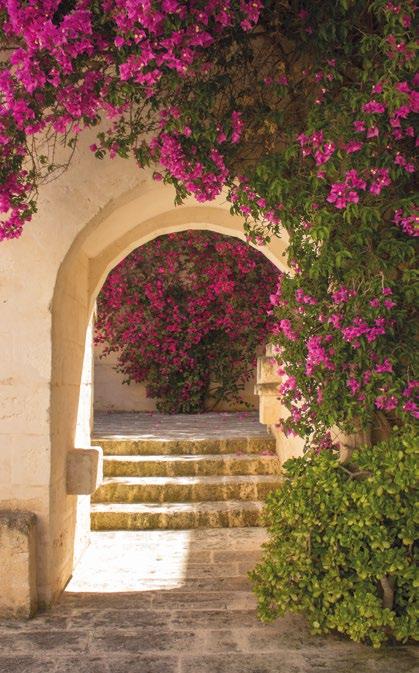
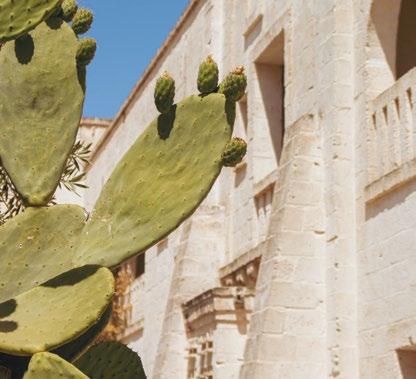
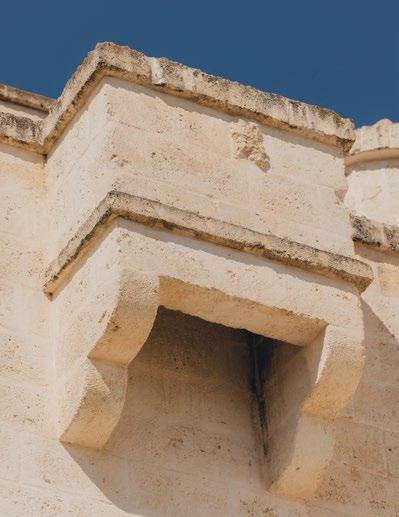

Go with the Wind
¬ Roberta GenghiMODELLA IL TERRITORIO, INFLUENZA LA PESCA E IL VINO, FORGIA IL CARATTERE E INDICA
DIPENDE SE TIRA SCIROCCO O MAESTRALE
It shapes the land, has an impact on wine and fishing, moulds people’s characters and dictates where the best seaside spots are, depending on whether it’s the Sirocco or the Mistral
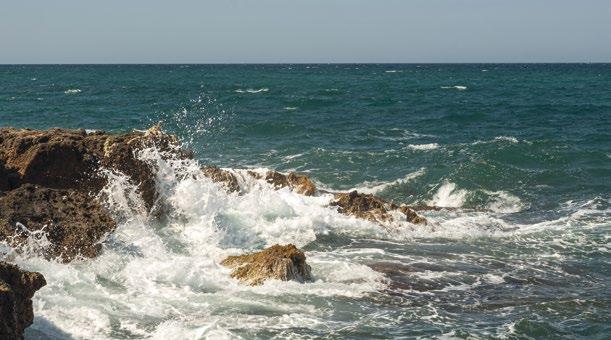
«Hai sentito mamma?». In quei giorni noi sorelle lo sappiamo già. E lo sappiamo prima ancora di sentirla, nostra madre. Basta affacciarsi al balcone. Probabilmente nostra madre sarà a letto in attesa che l’ennesimo analgesico faccia effetto. I giorni sono quelli gelidi del Maestrale o quelli caldissimi dello Scirocco. In quei giorni, se sei una persona meteoropatica, ti fa male la chèp, la testa. E mia madre lo è. E noi siamo pugliesi. E il vento lo conosciamo bene, perché con il vento nasciamo, cresciamo e moriamo.
Nel cuore del Mediterraneo, circondata quasi interamente dal mare, esposta all’influenza del mare Adriatico e del mar Ionio, con i suoi quasi 900 chilometri di costa, la Puglia è tra le regioni più ventose d’Italia.
Tramontana, Grecale e Maestrale. E poi ancora Scirocco, più raramente Libeccio. Questi – spiega il
“Have you heard from mum?” On those days, my sister and I already know. And we know it before we even hear from our mother. We simply need to pop out onto the balcony. Our mother will probably be in bed waiting for the umpteenth painkiller to kick in. The days in question are the ones when the freezing Mistral or the scorching Sirocco blow. On those days, if you’re meteoropathic then your chèp – your head – will hurt. My mother’s meteoropathic. And we’re Puglian, so we know the wind well because it’s with us from the day we’re born till the day we die.
With nearly 900 km of coastline in the heart of the Mediterranean, Puglia is almost entirely surrounded by the sea and both the Adriatic and the Ionian Sea have an impact on it, so it’s one of the windiest regions in Italy.
As well as the Tramontane, Gregale and Mistral, there’s the Sirocco and – less frequently – the Libeccio. These are
colonnello Vitantonio Laricchia, massima autorità regionale in materia di clima e meteorologia – sono i venti predominanti. I primi tre sono freschi, provengono dai quadranti settentrionali, si spostano lungo la fascia costiera adriatica e proseguono verso il canale d’Otranto. Gli altri arrivano da Sud. In autunno e in primavera c’è lo Scirocco, che soffia sul Mediterraneo con raffiche potenti cariche di umidità. Raramente c’è il Libeccio: si presenta prima come una brezza, per poi rafforzarsi nella mattinata.
Se sei in Puglia in estate, decidi dove andare al mare in base al vento. Arriva dal Nord? Mari mossi o agitati sulla fascia adriatica, quindi si va sullo Ionio dove le coste sono sottovento. Tira Scirocco? Si va sull’Adriatico. Già, è un vero lusso avere due mari!
La presenza dei venti ha da sempre caratterizzato la regione, influenzandone e modellandone il territorio, condizionando la cultura locale, tra miti, leggende e tradizioni le cui tracce sono visibili ancora oggi nel dna pugliese.
È il vento a dare il nome a tanti vini del territorio, Monte del Vento, Vento Bianco, Vento Rosso. Portatore sano di escursioni termiche giorno-notte, contribuisce alla fissazione degli acidi e degli aromi, donando freschezza e aromaticità al vino. Vento significa evitare umidità e muffe. Ed è proprio in base al vento (e al sole) che si decide l’esposizione del filare.
E ancora è il vento che condiziona e influenza la pesca. «Dopo il Garbino (Libeccio, ndr), c’è il Maestrale fino: lo diceva sempre nonno Mimì (quello del famoso Trabucco da Mimì, a Peschici)», racconta il nipote Vincenzo. «Come ogni movimento del mare, il vento eccita i pesci. Ecco perché prima e dopo la tempesta si pesca bene».
I venti pugliesi raccontano tanto di chi siamo: sognatori, romantici, allegri, ospitali, e poi ancora orgogliosi, ipercritici, testardi, passionali, un po’ folli e un po’ geniali all’occorrenza.
Penso ad Angelo, il protagonista di Monteruga, il primo romanzo di Anna Puricella, a cui lo Scirocco toglie il sentimento e il respiro. «In dialetto salentino lo chiamano faùgnu», spiega la scrittrice. «È fastidioso, si appiccica alla pelle e fa sragionare».
«Quando c’è Scirocco le cose funzionano male, anche i pensieri si attaccano addosso, come sanguisughe», canta Paolo Benincasa. Mentre Mapi, che di mestiere fa la traduttrice, quando sbaglia le parole in un discorso o le scandisce male dice: «Oggi è Scirocco». Parla invece di un amico quando evoca il Maestrale. Amico perché spinge lontano le perturbazioni e porta ampie schiarite. È lui il vento forte del cambiamento: all’inizio la burrasca ci fa paura, ma in fondo lo sappiamo che andrà tutto bene.
the prevailing winds, explains Colonel Vitantonio Laricchia, the region’s leading climate and meteorology expert. The first three are cold and they come from a northerly direction, moving down the Adriatic coast and continuing towards the Strait of Otranto. The other winds come from the South. In autumn and spring there’s the Sirocco, which sends powerful gusts full of moisture over the Mediterranean. On the rare occasions when the Libeccio blows, it starts out as a breeze and then gets stronger over the course of the morning.
During the Puglian summer, you need to consider the wind when deciding where to spend a day by the sea. If it’s coming from the North, the Adriatic will be rough or choppy so the sheltered Ionian coast is the best bet. If the Sirocco’s blowing, head to the Adriatic. Having a choice of two different seas is a real luxury!
The various winds have always played a big part in the region. They have shaped and made their mark on the land and the local culture, giving rise to myths, legends and traditions whose traces can still be seen in the Puglian DNA today.
The Italian word for wind – Vento – appears in the names of many local wines, such as Monte del Vento, Vento Bianco and Vento Rosso. As sommelier, oenologist and blogger Gianpaolo Priore says with a smile, “the wind brings healthy temperature differences between the day and night, helps to firmly establish acids and aromas, and makes wine fresh and aromatic. It can also prevent moisture and mould. When deciding on the aspect of rows of vines, it’s the wind (and sun) that you take into account.”
The wind also has an impact on fishing. “The Garbino (Libeccio – ed.) is followed by a gentle Mistral: that’s what Grandad Mimì (from the famous Trabucco da Mimì in Peschici) always used to say,” reveals Vincenzo. “Like all movement in the sea, the wind stirs up the fish. That’s why the fishing’s good before and after storms.”
The Puglian winds say a lot about who we are: cheerful, hospitable and romantic dreamers, who are proud, hypercritical, headstrong and passionate. When the need arises, we can be a little crazy and a little inspired.
Take Angelo, the protagonist in Monteruga, which is Anna Puricella’s first novel. The Sirocco takes both his breath and his feelings away. “In the dialect of Salento, they call it faùgnu,” explains the writer. “It’s irksome. It sticks to your skin and stops you from thinking rationally.”
“Nothing works properly when the Sirocco blows. Even thoughts cling on like leeches,” sings Paolo Benincasa. Mapi’s an interpreter. When she gets the words in a speech wrong or doesn’t articulate them properly, she says: “The Sirocco’s blowing today.” In contrast, she thinks of the Mistral as a friend because it carries bad weather far away and leads to long sunny spells. It’s a strong wind of change: the gales might be a little scary at first, but deep down we know everything will be OK.
A Little Eden for Ancient Fruits
¬ Luca BergaminCOMPIE TRENT’ANNI IL PROGETTO DEL FOTOGRAFO MILANESE CHE SI È TRASFERITO A CISTERNINO PER PROTEGGERE NEL SUO GIARDINO PIANTE RARE E DIFENDERE LA BIODIVERSITÀ
The project of a Milanese photographer who moved to Cisternino to protect rare plants and defend biodiversity in his gardens turns thirty
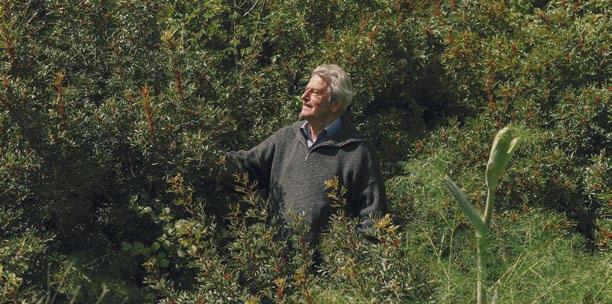
Paolo Belloni by Flavio&Frank.
Paolo Belloni e il suo cane Lara formano una coppia inseparabile. Insieme accolgono eminenti professori di botanica, giovani studenti e appassionati di flora nel loro piccolo eden, i Giardini di Pomona, un conservatorio botanico fondato trent’anni fa, nel 1994, immerso tra i milioni di ulivi della Valle d’Itria nella campagna che da Cisternino arriva al Mare Adriatico. Paolo, fotografo milanese con la passione per la natura, ha scelto la Puglia per realizzare il suo progetto: proteggere, e in qualche caso salvare, le piante antiche da frutto per dare un concreto contributo alla biodiversità e trasmetterla alle generazioni future. Una sorta di Arca di Noè vegetale.
Nei dieci ettari dei Giardini di Pomona (il nome è dedicato alla dea pagana dei frutti, ndr) sono state messe a dimora oltre mille specie di alberi da frutto per sottrarle a una quasi sicura estinzione. Tra queste, seicento sono varietà di Ficus carica provenienti dalla Francia, dalla Bosnia, dal Portogallo, dall’Albania e da altri paesi, e insieme formano una delle più importanti collezioni del Mediterraneo. Paolo cura le piante con amore, ne raccoglie i frutti e li trasforma in deliziose conserve. Quando i fichi maturano,
Paolo and his dog, Lara, are an inseparable pair. Together, they welcome eminent botany professors, young students, and flora enthusiasts to their little Eden, the Pomona Gardens, a botanical conservatory founded thirty years ago, in 1994, nestled among the millions of olive trees of the Itria Valley in the countryside that stretches from Cisternino to the Adriatic Sea. Paolo, a Milanese photographer with a passion for nature, chose Puglia to bring his project to life: to protect, and in some cases preserve, ancient fruit plants, make a concrete contribution to biodiversity, and pass it on to future generations. A sort of botanical Noah’s Ark.
In the ten hectares of the Pomona Gardens (the name is inspired by the pagan goddess of fruit, ed.), more than a thousand species of fruit trees have been planted to save them from almost certain extinction. Among them, six hundred are varieties of Ficus carica (fig) from France, Bosnia, Portugal, Albania, and other countries, and together they form one of the most impressive collections in the Mediterranean. Paolo tends his trees with love, harvests the fruit, and turns it into delicious preserves. When the figs ripen, they are cut in half, opened,
vengono tagliati a metà, aperti e lasciati a essiccare su letti di fascine per qualche settimana. Quindi si richiudono inserendo tra le due parti una mandorla e si conservano fino all’inverno per gustarli come dolce ricordo dell’estate.
Scortati dalla scodinzolante Lara, si esplora il parco tra i trulli. Si attraversa l’area dei melograni, quella dei peri e dei meli, con specie rare come la Api Etoilé reintrodotta in Italia proprio grazie al progetto di Pomona. E sono già sbocciate le zagare profumate degli agrumi: limoni, aranci, pompelmi, mandarini, chinotti, esemplari originari della collezione di Cosimo III de’ Medici, e il robusto Poncirus trifoliata, un arancio spinoso che resiste al freddo e si presta agli innesti. La sfida è creare un ponte botanico tra il passato e il futuro, come dimostra il prezioso esemplare di Cachi di Nagasaki, cresciuto da una piantina resiliente che si è salvata dalla devastazione della bomba atomica sganciata dagli americani in Giappone il 9 agosto 1945. Quel cimelio botanico fu recuperato e curato come simbolo di speranza, ed è una grande emozione raggiungerlo al centro di un labirinto di lavanda, come simbolo dello sforzo per ritrovare la pace.
Tutto viene fatto come una volta. Si irriga a mano, si usa il cippato per evitare sprechi di acqua, si costruiscono muretti a secco per proteggere le piante dalla Tramontana. Così, rosmarini, timi, salvie, mente, issopi, artemisie ma anche citronella, ruta, melissa, canfora crescono sani e rigogliosi. L’aria è profumata e i sensi si inebriano.
Ma Paolo è sempre alla ricerca di semi e ramoscelli a cui dare una casa sicura. L’ultima sfida è coltivare i kiwi senza pelo e rendere nuovamente fertili i terreni, introducendo anche piante che richiedono pochissima acqua e resistono alla desertificazione. In questo spicchio di Puglia, tra ciliegi, mandorli, giuggiole ed erbe aromatiche, Paolo sta riuscendo a compiere un’impresa davvero titanica.
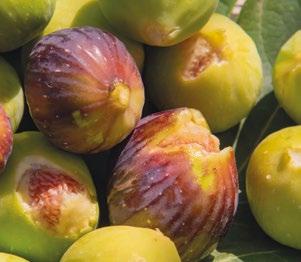
and left to dry on the traditional reed drying racks for a few weeks. Then they are closed again, inserting an almond between the two halves, and stored until winter to be enjoyed as a sweet reminder of summer.
Escorted by Lara, happily wagging her tail, visitors can explore the park among the typical Puglian trulli, surrounded by pomegranate, pear, and apple trees, including rare species such as the Api Etoile apple reintroduced to Italy thanks to the Pomona project. The fragrant orange blossoms of citrus fruits have already opened: lemons, oranges, grapefruits, mandarins, and chinottos, specimens that could originally be found in the collection of Cosimo III de' Medici, and the robust Poncirus trifoliata, a thorny orange tree that resists the cold and lends itself to grafting. The challenge is to create a botanical bridge between the past and the future, as shown by the precious specimen of Nagasaki persimmon, grown from a resilient seedling that survived the devastation of the atomic bomb dropped by the Americans in Japan on 9 August 1945. The botanical heirloom was rescued and cared for as a symbol of hope, and it is thrilling to come upon it in the middle of a lavender labyrinth as a symbol of the effort to restore peace.
Everything is done as it used to be. Irrigation is done by hand, wood chips are used to avoid wasting water, and dry-stone walls are built to protect the plants from the cold Tramontane wind. Thus, rosemary, thyme, sage, mint, hyssop, and artemisia, as well as citronella, rue, lemon balm, and camphor, grow healthy and lush. The air is scented, and the senses become inebriated.
But Paolo is always on the lookout for seeds and twigs to give them a safe home. The latest challenge is to cultivate hairless kiwis and make the soil fertile again by introducing plants that require very little water and resist desertification. In this slice of Puglia, among cherry trees, almond trees, jujubes, and aromatic herbs, Paolo is accomplishing a truly epic feat.

Model of Good Tourism
¬ Carmen Rolle ¬ Ph. Giuseppe LanotteTORRE GUACETO È UN MICROCOSMO INCANTEVOLE TRA TERRA E MARE. ENTRARE SI PUÒ, MA SENZA LASCIAR TRACCIA DEL PROPRIO PASSAGGIO. PER OSSERVARE GLI UCCELLI MIGRATORI, NUOTARE TRA I CORALLI E APPLAUDIRE LE TARTARUGHE GUARITE CHE TORNANO IN LIBERTÀ
Torre Guaceto is a mesmerising microcosm nestled between land and sea. You can enter, but gently, leaving no trace of your passage. It's a place to observe migratory birds, swim among coral beds, and applaud healed turtles as they return to freedom
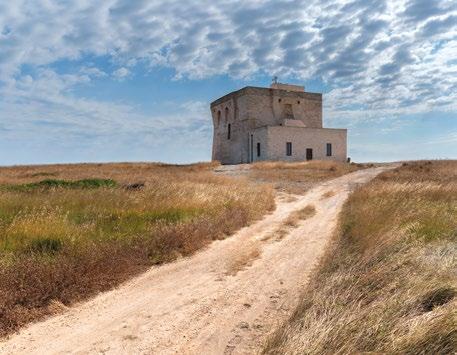
La distesa di ulivi secolari, i canneti mossi dal vento, gli odori della macchia mediterranea. E il mare che si infrange, turchese, su sabbie e falesie dorate. Sono le spiagge di Torre Guaceto, da anni menzionate tra le più belle d’Italia. Fanno parte di un ambiente che è contemporaneamente area marina protetta e riserva naturale terrestre, unico caso insieme a Ventotene. Un sistema riconosciuto anche oltre i confini nazionali: durante l’ultimo Ocean Day, lo scorso 6 marzo 2024, questa area incontaminata tra Brindisi, Carovigno, Mesagne e San Vito dei Normanni si è aggiudicata il prestigioso Mpa Award della Commissione Europea, che premia le migliori aree marine del nostro continente. La tutela, però, non è mai abbastanza. Per conservare l’equilibrio di natura e attività umane è stato avviato il percorso per diventare Riserva della Biosfera Unesco. E da quest’estate, 60 volontari si alternano per una maggiore difesa dell’ambiente e degli animali.
In queste foto, Torre Guaceto, patrimonio Unesco e oasi Wwf.
In these photos, Torre Guaceto, both a Unesco World Heritage Site and a Wwf Oasis.
Amidst centuries-old olive trees, windswept reeds, and the wafting scents of the Mediterranean scrub, the turquoise sea crashes onto golden sands and cliffs. These are the beaches of Torre Guaceto, long hailed as some of Italy’s finest. They form part of an ecosystem that is both a marine protected area and a terrestrial nature reserve, a unique case in Italy along with the island of Ventotene. Internationally recognised, during the 2024 Ocean Days, from 4th to 8th March, this pristine area between Brindisi, Carovigno, Mesagne, and San Vito dei Normanni was given the prestigious MPA Award by the European Commission, celebrating the best marine areas across our continent. However, protection is never enough. So to preserve the balance of nature and human activities, the pathway for this area to become a Unesco Biosphere Reserve has been initiated. Starting this summer, sixty volunteers will be rotating to better defend both the environment and the wildlife.
Oggi la riserva tutela circa 3.000 ettari di territorio, più di 8 chilometri di costa, in un paesaggio che allinea campi coltivati e uliveti, macchia mediterranea e canneti, stagni e dune, scogli e baie sabbiose, con sentieri da percorrere in bici o a piedi, con le guide della Cooperativa Thalassia. Pedalando in silenzio tra aironi, falchi, folaghe e tante altre specie di uccelli migratori e no, si raggiunge la cinquecentesca torre aragonese che dà il nome alla riserva: dentro c’è un’imponente riproduzione di un’antica nave romana che serviva per il trasporto di olio e vino nel Mediterraneo.
Ma c’è molto altro da esplorare. Con maschera e pinne si nuota fino alla zona più protetta dove saraghi, occhiate, donzelle, sciarrani danzano su praterie di posidonia e coralli, anemoni e gorgonie. Sembrerà strano, eppure nel parco è ammessa la pesca. Non solo, dal 2017 il modello locale è stato dichiarato Presidio Slow Food, perché i pescatori si impegnano a uscire solo una volta alla settimana e a utilizzare reti a maglia larga per non catturare i pesci piccoli. Così le acque si sono ripopolate e sono tornate specie ritenute scomparse. Anche in superficie si coltivano buoni propositi e prodotti di qualità, come l’olio biologico di ulivi millenari – Oro del Parco – e il dimenticato pomodoro fiaschetto, piccolo succoso e pizzuto, perfetto per le salse pugliesi, anch’esso Presidio Slow Food dal 2008. Mentre nel centro di recupero delle tartarughe marine si curano piccole e grandi testuggini dalle storie commoventi. Arrivano ferite da ami, scafi e reti da pesca, o indebolite per aver ingerito plastica che scambiano per meduse e lì restano fino alla completa guarigione, quando vengono rimesse in mare con una festa gioiosa a cui possono partecipare tutti. Insomma, il modello di sviluppo di Torre Guaceto punta a far prosperare insieme agricoltura sostenibile, pesca responsabile e, soprattutto, turismo consapevole.
Today, the reserve protects about 3,000 hectares of land and over 8 kilometres of coastline in a landscape of cultivated fields and olive groves, Mediterranean scrub and reed thickets, ponds and dunes, cliffs and sandy bays, with trails to be explored by bicycle or on foot with guides from the Cooperativa Thalassia. Pedalling in silence among herons, hawks, coots, and many other species of birds, you reach the sixteenth-century Aragonese tower that gives its name to the reserve. Inside, there's an impressive replica of an ancient Roman ship once used to transport olive oil and wine across the Mediterranean.
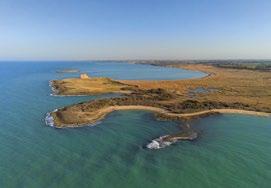

There's much more to discover. With a mask and flippers, you can swim to the most protected area, where white bream, saddled bream, rainbow wrasse, and comber dance over beds of seagrass, coral, anemones, and gorgonians. Surprisingly, fishing is allowed in the park. Moreover, since 2017, the local model has been designated a Slow Food Presidium because the fishermen commit to going out only once a week and using largemesh nets so as not to catch small fish. Consequently, the waters have repopulated, and species believed to be extinct have returned. Also on the land, good intentions and quality products are cultivated, like the organic oil from millennial olive trees — Oro del Parco — and the overlooked Pomodoro Fiaschetto, a small juicy plum tomato perfect for Puglian sauces, also a Slow Food Presidium since 2008. The sea turtle recovery centre cares for both small and large turtles with touching stories. They arrive wounded by hooks, hulls, and fishing nets or weakened by having ingested plastic they mistake for jellyfish, and remain there until fully healed, when they are released back to the sea in a joyful celebration open to all. In short, the development model of Torre Guaceto aims to ensure that sustainable agriculture, responsible fishing, and above all, conscious tourism can flourish together.
Anche se in piena estate il lido con gli ombrelloni in paglia è un po’ affollato, basta spostarsi verso altre calette, fino alla meravigliosa «spiaggia delle conchiglie». La chiamano così perché è composta dai gusci di oltre 130 specie di molluschi, portati dalla corrente e dai venti del Nord. E benché frantumati dalle onde, prendendoli tra le mani se ne trovano molti interi, luccicanti ai raggi del sole. Un’altra magia.
Even if the lido with its thatched umbrellas gets a bit crowded in the height of summer, you can simply move on to other coves, up to the enchanting “shell beach”, so called because it is made up of shells of over 130 species of molluscs brought by the currents and the northern winds. And even though many are shattered by the waves, scooping up the shells in your hands you’ll find some still whole, glistening in the sunlight. Another piece of magic.
A TERLIZZI OGNI ANNO, NEL PRIMO GIORNO FESTIVO DI AGOSTO, UN CARRO TRIONFALE PROCEDE TRA LA FOLLA ENTUSIASTA PER RICORDARE COME IL BORGO SI AGGIUDICÒ L’EFFIGIE DELLA MADONNA NERA
In Terlizzi, every year on the first Sunday of August, a triumphal float parades through the enthusiastic crowd to commemorate how the town acquired the effigy of the Black Madonna
Musicisti precedono il carro trionfale durante la sfilata del sabato sera a Terlizzi.
Musicians precede the triumphal float during the Saturday evening parade in Terlizzi.
Il pranzo fugace a mezzogiorno, orario insolito per la domenica. Il riposo fino al tardo pomeriggio. La sveglia della famiglia, la doccia, il vestito buono e la corsa verso viale Roma, per accaparrarsi le prime file tra le luminarie che campeggiano da giorni in attesa di accendersi tra la meraviglia di migliaia di persone. Il carro trionfale è lì, altissimo, 22 metri, assemblato per diventare il protagonista della Festa Maggiore. Accade ogni prima domenica di agosto per dar vita, tra sussulti, peripezie, forza ed entusiasmo, alla sua marcia lungo le vie strette del centro di Terlizzi, fino all’arrivo davanti alla cattedrale. Il compito, già dal 1700, è quello di portare fino al sagrato della cattedrale l'effigie di Maria dalla pelle scura, che rivela le origini bizantine del suo culto.
È a lei, la Madonna di Sovereto, borgo medievale fuori le mura della città dei fiori, che è dedicata la festa e la devozione dei cinquanta «spingitori». Sono loro, schierati e nascosti dagli addobbi sotto la base al di qua delle grandi ruote, a muovere tra sudore ed esaltazione il fardello del carro con i quattro timonieri e il loro capo, pronto a guidarli. Il caldo e la fatica non li spaventa, le loro energie sono protese a macinare metri, a evitare incidenti, a contenere sbandate, mentre la cima sfiora piccoli balconi assiepati da fedeli e rischia di far saltare le insegne dei negozi lungo il percorso di due chilometri, tra urla ed entusiasmo. Le famiglie si preparano così all’evento. Alcune in maniera speciale, perché cento dei loro bambini, vestiti per la cerimonia, sono i candidati a salire proprio sul carro. La
preparazione di spingitori e timonieri si consuma tra la benedizione, i riti non confessati e il collaudo nei giorni prima della festa: quattro ore di adrenalina che si accende per le 21 all'unisono, con un boato, assieme alle luci del carro, per sorprendere i forestieri ed essere a malapena contenuta dai volontari e dal battaglione dei carabinieri.
Il rito nasce da un ritrovamento, da una contesa e dal sangue. La contesa è quella tra Terlizzi e la vicina Bitonto sull'appartenenza dell'immagine di Maria. Tra leggenda e storia, si racconta di un pastore che smarrisce una pecora nelle campagne. La ritrova in un anfratto, dove una lanterna arde miracolosamente davanti all’immagine della Madonna. La voce si sparge e accorrono i CONTINUA >
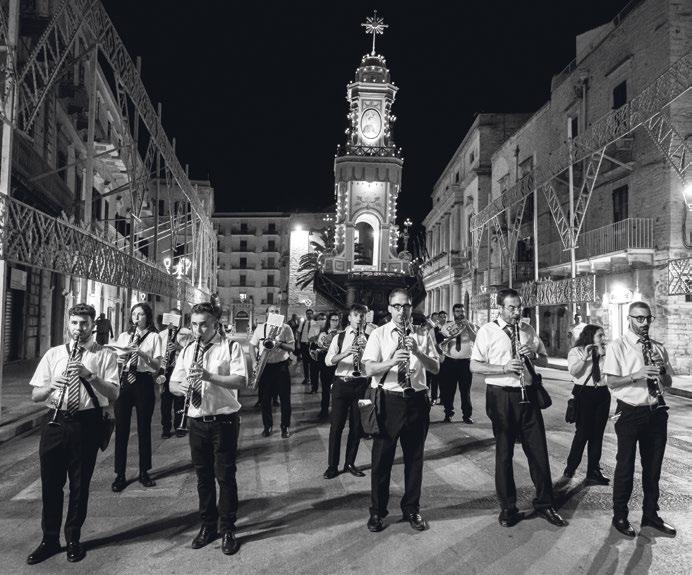
A quick lunch at noon, an unusual time for a Sunday. A rest until late afternoon. Then the family wakes up, showers, dresses in their Sunday best, and hurries to Via Roma to secure front row places among the luminarie decorations that have been set up for days, ready to be illuminated to the amazement of thousands. The triumphal float is there, towering at 22 metres, assembled to become the protagonist of the Festa Maggiore. It happens every first Sunday of August, when the procession of the enormous float along the narrow streets of the historic centre of Terlizzi is animated with sudden jolts, risky manoeuvres, and muscle power, all to the excitement of the crowd, until it reaches the cathedral. Since 1700, the job of the massive float has been to transport the effigy of the Madonna, whose dark skin reveals the
Byzantine origins of her veneration, to the cathedral square.
It is to her, the Madonna of Sovereto—a medieval village outside the walls of Terlizzi, the “city of flowers”—that the festival and the devotion of the fifty “pushers” are dedicated. Lined up in rows and hidden by the decorations under the base of the float beside the large wheels, the pushers move the float’s burden with sweat and exhilaration, along with the four helmsmen and their leader ready to guide them. They are not deterred by the heat and the fatigue; their energies are strained to cover the distance, to avoid accidents, to keep the float steady as it barely misses grazing balconies crowded with the faithful and risks knocking down shop signs along the two-kilometre route amidst the shouts and excitement. Families prepare for the
event in this way, some in a special manner, as a hundred of their children, dressed for the ceremony, are chosen to climb up and ride on the float. In the days leading up to the festival, the pushers and helmsmen make their own preparations between blessings, unspoken rituals, and rehearsals, culminating in four hours of adrenaline that ignites at 9 p.m. with a roar in unison as the float is illuminated, dazzling the spectators, while it is precariously guarded by the volunteers and the battalion of carabinieri.
The ritual of the Festa Maggiore stems from a discovery, a dispute, and bloodshed. The dispute was between Terlizzi and the nearby town of Bitonto over the ownership of the image of the Madonna. Legend and history tell of a shepherd who has lost a sheep in the countryside, then finds it CONTINUES >
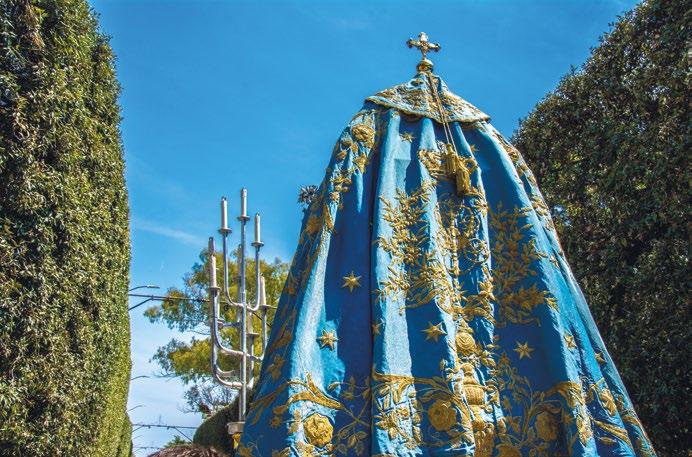
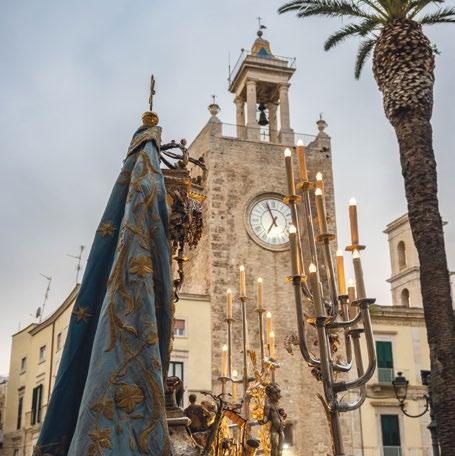
In occasione della Festa Maggiore, la Madonna di Sovereto viene portata in processione per la città.
The Madonna di Sovereto is brought in procession around the city on the day of the Festa Maggiore.
fedeli di Bitonto e Terlizzi che si contendono l’altare. Decidono di affidarsi al giudizio divino aggiogando due tori a un carro con il sacro fardello. Il toro vincente orienta il carro verso Terlizzi, dove arriva colmo di fiori e prodotti della terra, tra l'acclamazione della gente, che da allora ne conserva orgogliosa il rituale.
Ed eccolo il Trionfale di proprietà del Comune (rifatto dopo un incendio nel 1991), maestoso, colorato. Lo si ammira nel suo stile barocco prima che affronti ondeggiando, tra ali di folla, il percorso che riserva le quattro curve più insidiose, strette tra le case in tufo del centro. Una macchina da festa concepita fin dai primi del Settecento, che conserva in sé l'incontro tra l'arte e la cultura del profano e quella religiosa. In cima prende le sembianze di un campanile e in basso, un tempietto ricco di affreschi e decorazioni artigianali ricorda un galeone. È l'ente civico ad affidarlo alla curia e al comitato per i festeggiamenti.
«L'ho vissuto per vent'anni – ricorda il sindaco Michelangelo De Chirico –sotto le sue ruote, a un palmo dalla fatica e l'entusiasmo degli spingitori, sopra i terrazzi sui quali saltavo dopo aver approntato una planimetria del percorso per evitare la Afolla e piombare davanti. Affiancavo mio zio, Giuseppe De Palma, il fotografo della manifestazione, che nel 1943 fu pastorello sul carro. Si correva a sviluppare i rullini per arricchire l'archivio e vendere gli scatti ai turisti. Tanti. Perché è una festa che richiama il turismo delle radici».
in a grotto where a lantern is burning miraculously in front of the effigy of the Madonna. Word spreads, and believers from Bitonto and Terlizzi rush to contest the altar. To resolve the dispute, they decide to rely on divine judgment by yoking two oxen to a cart bearing the sacred burden. The winning ox steers the cart towards Terlizzi, arriving laden with flowers and fruits of the earth amidst the cheers of the people, who have proudly preserved the tradition since then.
And there it stands, the float known as the Trionfale (Triumphant), majestic and colourful, the property of the municipality, rebuilt after a fire in 1991. It pauses to be admired in its Baroque style before swaying through the crowds along the route that includes four treacherous curves, squeezed between the tufa houses of the old town centre. An amazing festival apparatus conceived in the early 1700s that preserves the convergence of secular and religious art and culture. Up at the top, it takes the form of a bell tower, and at the bottom, a temple with frescoes and artisan decorations resembles a galleon. The float is entrusted to the curia and the festival committee by the municipality.
"I experienced it for twenty years," recalls Mayor Michelangelo De Chirico, "underneath where the wheels are, a hand’s breadth from the effort and enthusiasm of the pushers, over the balconies that I jumped on after making a plan of the route I’d take to avoid the crowd and emerge in front. I accompanied my uncle Giuseppe De Palma, the event photographer, who in 1943 was the shepherd boy on the float. We would hurry to develop the rolls of film to add to the archive and sell photos to the tourists. Lots of tourists! Because it’s a festival that attracts visitors who are passionate about tradition."
Il
tempo è scandito dall’incedere della banda e dagli applausi della folla che sembra fluttuare lungo il percorso
Time is marked by the march of the band and the applause of the crowd that seems to waft along with the float on the route
Le lampadine ne definiscono i contorni. All’interno, la statua di San Michele, l’icona della Madonna, arrivata da Sovereto il sabato e il gruppo vivente della pecora con il pastorello. La rievocazione dell’antica contesa la si coglie dai tori raffigurati alla base. Salgono i bambini sulla gradinata interna. Le luci si accendono e i quattro timonieri si dispongono ai lati dell’asse in legno massiccio realizzato appositamente dalla falegnameria Cataldo. Il loro ruolo è il più delicato. Con un fischietto il capo li guida e loro procedono a gambe leggermente divaricate, con una postura ritta in grado di assorbire sobbalzi e far fronte agli CONTINUA > CONTINUES >
Small lights outline the icon’s niche. Inside the float are the statue of St. Michael, the icon of the Madonna that arrived from Sovereto on Saturday, and the live sheep with the shepherd boy. The re-enactment of the ancient dispute is represented by the oxen depicted at the base. Children climb up the internal steps. The lights are switched on, and the four helmsmen position themselves on either side of the specially made solid wooden drawbar. Their role is the most critical
Sotto, il montaggio del carro. Pagina accanto, il carro incorniciato da una miriade di luci calde.
Below, men building the float. Opposite page, the float framed by a myriad of warm lights.
imprevisti. Il ritmo è scandito dall’incedere della banda e dagli applausi della folla che sembra fluttuare assieme al carro lungo il percorso, quest’anno delineato dalle maestose luminarie artistiche di Massimo Mariano di Scorrano. Strutture ancorate più che altrove agli edifici per reggere il rituale e l'impeto della folla.
«Lo scorso anno – racconta con orgoglio Michelangelo Matacchione, presidente del comitato della festa, che ha organizzato come novità manifestazioni collaterali e concerti aperti a tutti fino al giovedì – il manto stradale ha ceduto per qualche centimetro, una ruota è finita in un solco e il timone si è spezzato. Abbiamo preso quello di scorta e lo abbiamo sostituito in 10 minuti, liberando il carro spinto in retromarcia, tra il boato della gente». Un incidente che non ha impedito al corteo di arrivare davanti alla cattedrale poco dopo la mezzanotte tra il fragore dei fuochi d’artificio e l’ovazione di migliaia di persone, con le famiglie e i bimbi soddisfatti nel loro vestito buono provato dalle peripezie della festa, pronti poi a perdersi per il resto della notte tra gli odori e le fragranze tipiche delle carni alla brace. Come per tradizione, accadrà ancora una volta la prima domenica d'agosto.
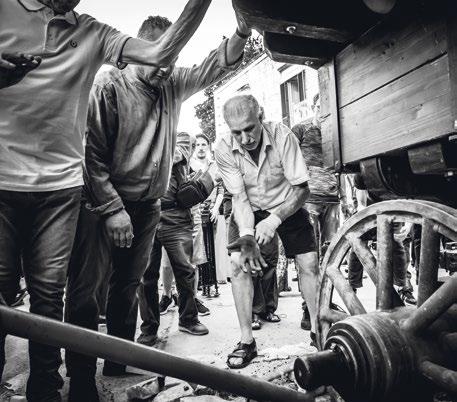
of all. With a whistle, the head helmsman guides them, and they proceed with their legs slightly splayed, a posture that is upright enough to absorb the jolts and handle the unexpected. The rhythm is marked by the march of the band and the applause of the crowd that seems to waft along with the float on the route, which this year is delineated by the majestic luminarie created by Massimo Mariano of Scorrano. Here, the lighting structures are anchored to the buildings more firmly than elsewhere to support the procession and the surge of the crowd.
"Last year," proudly recounts Michelangelo Matacchione, president of the Festival Committee, which now organises side events and concerts open to all until Thursday, "the road surface gave way by a few centimetres, a wheel ended up in a rut, and the drawbar broke. We took the spare and replaced it in ten minutes, freeing the cart pushed backwards amidst the roar of the crowd." The incident did not prevent the procession from arriving in front of the cathedral just after midnight amidst the boom of fireworks and the ovation of thousands of people, with satisfied families and children in their Sunday best worn out by the festival adventures, ready to lose themselves for the rest of the night among the aromas and flavours of grilled meats. As tradition dictates, the Festa Maggiore will happen once again on the first Sunday of August.
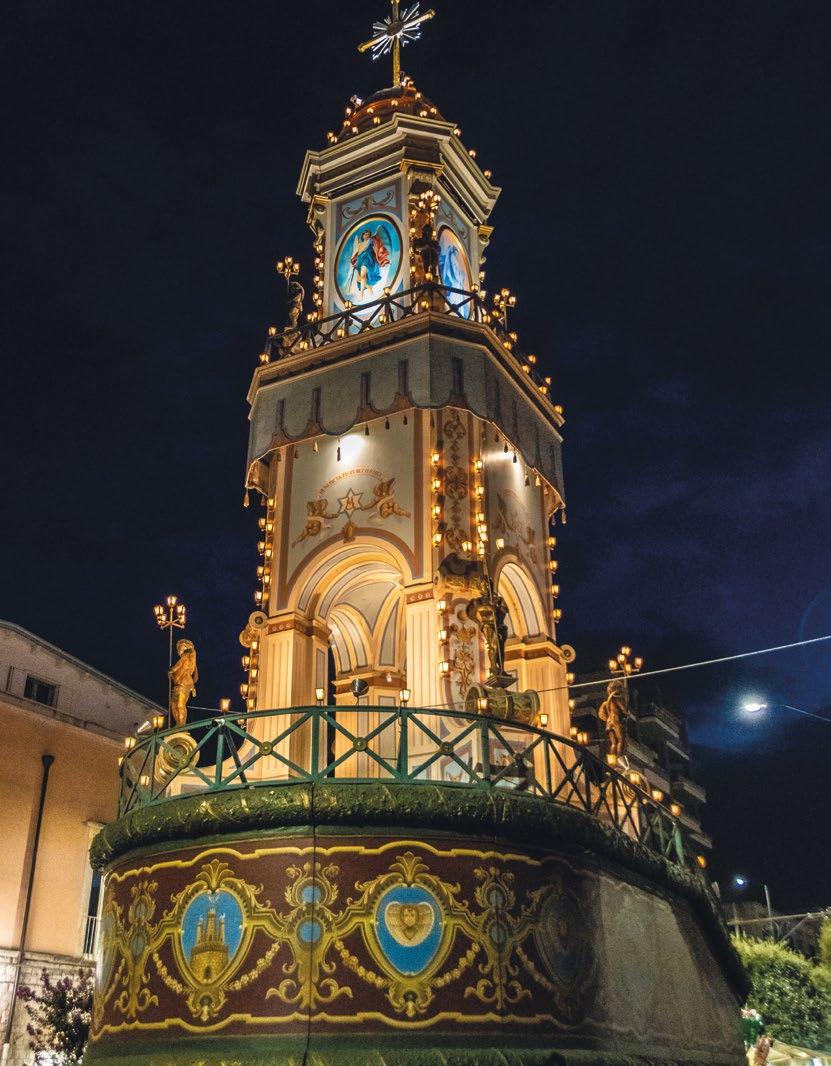
¬ Martina Papagni
This dish, based on just three simple ingredients, can only be found in this region. Don't bother searching elsewhere; without the essence of Puglia, it's merely an imitation
 Patate, riso e cozze, piatto tipico barese, ormai diffuso in tutta la Puglia.
Patate, riso e cozze, piatto tipico barese, ormai diffuso in tutta la Puglia.
Patate, riso e cozze. Anzi, Patateris’ecozz, tutto attaccato, proprio come si dice a Bari. Questa ricetta di famiglia ha molteplici versioni, ma la vera tiella si prepara così, come spiega lo chef stellato Domingo Schingaro.
- 1,5 kg cozze a mezzo guscio
- 1,5 kg patate
- 500 g di pomodorini
- 400 g riso arborio (o riso giallo, come lo chiamavano le mamme di una volta)
- 1 cipolla rossa di Acquaviva delle Fonti
- 1 spicchio d’aglio
- Nu muers d Rodez (ovvero pecorino Rodez q.b.)
- Prezzemolo
- Un pizzico di sale e abbondante pepe
Dalla vostra pescheria di fiducia, fate preparare le cozze «a mezzo guscio» (ovvero divise a metà, conservando una delle due valve, ndr), ma ricordatevi di conservarne l’acqua. Per rendere il piatto più saporito, è meglio preparare tutto il giorno prima.
«Mo vi spiego», dice chef Schingaro.
Tagliate le patate a fette, né troppo spesse né troppo sottili (immaginate, se potete, su per giù due millimetri). Immergetele in acqua mista a quella delle cozze e aggiungete prezzemolo, pomodorini, cipolla tagliata sottile sottile (alla julienne, ndr), aglio tritato e una manciata di pecorino Rodez. Anche se non è un prodotto pugliese, un tempo era molto più economico e viene utilizzato ancora oggi nella ricetta originale. Aggiungete acqua sufficiente per coprire gli ingredienti, un filo di olio e abbondante pepe. Di sale ne basta poco, ma potete addirittura non aggiungerlo.
Il giorno dopo, disponete in una tiella un primo strato di patate, pomodori, cipolla e formaggio. Idealmente, ci vorrebbe una bella terracotta, ma va bene anche un tegame di ferro. Posizionate quindi le cozze con il guscio rivolto verso l'alto e spolverate di riso crudo fino a coprirle completamente, come se fosse formaggio sulla pasta. Aggiungete del pecorino e coprite con un ulteriore strato di patate.
Mo arriva la parte difficile: versate nella tiella l'acqua delle patate ottenendo un effetto palude, come spiega lo chef. Né troppa, né troppo poca: il giusto.
Spolverate con altro pecorino e coprite con stagnola. Portate a bollore sul fuoco, poi cuocete in forno a 180 °C per 90 minuti. Negli ultimi dieci minuti, rimuovete la stagnola per gratinare la superficie. Una volta pronto, non fatevi tentare e lasciate riposare il piatto almeno per una notte. Mangiato il giorno dopo, è tutta un’altra cosa.
Potatoes, rice, and mussels. Patateris’ecozz—one word, no spaces, like they pronounce it in Bari. This family recipe has many adaptations. However, the true Tiella Barese is prepared exactly as Domingo Schingaro, a Michelin-starred chef, explains.
- 1.5 kg half-shelled mussels
- 1.5 kg potatoes
- 500 g cherry tomatoes
- 400 g arborio rice (or yellow rice, like Puglian mums always called it)
- 1 red onion from Acquaviva delle Fonti
- 1 clove of garlic
- ‘Nu muers d Rodez’ (lit. grated Rodez cheese)
- Parsley to taste
- A pinch of salt and plenty of pepper
Ask your trusted local fishermen to prepare “halfshelled” mussels (i.e., split in half, keeping only one of the two shells), but keep the water they came with. To make the recipe a lot tastier, start preparing everything the day before.
“Mo vi spiego” (lit. “Let me explain”).
Slice the potatoes to the right thickness—not too thick or too thin (try and imagine, if you can, about two millimetres). Cover them with water mixed with the mussel water, adding the parsley, cherry tomatoes, julienne-sliced onion (very thin or sottile sottile, as the chef says), minced garlic, and a good handful of Rodez pecorino cheese. Although not originally from Puglia, this type of cheese was once much cheaper and is still used in the original recipe. Add more water to cover the ingredients, a drizzle of extra-virgin olive oil, and plenty of pepper. A little salt is enough, but it’s entirely optional.
The next day, start by spreading a first layer of potatoes, tomatoes, onion, and cheese in a tiella (a traditional terracotta oven dish), or any metal oven dish will also do. Place the mussels facing up in the tiella, then evenly sprinkle uncooked rice to fully cover them, as if it were cheese over pasta. Add another handful of Rodez and top with a final layer of potatoes.
Mo (lit. "now") comes the hardest part. Pour into the tiella the water previously used to “preserve” the potatoes. It has to look like a "swamp," explains the chef; that is, add neither too much nor too little water. Il giusto, meaning “just right”.
Finally, sprinkle more cheese, cover with foil, and boil on the stove. Then, bake at 180°C for 90 minutes, removing the foil for the last 10 to brown the top. Once ready, don’t let yourself be tempted and let it rest overnight. When eaten the next day, this dish is something else entirely.
Raw Seafood
¬ Francesca D’Agnano
It is an exquisite food with wide appeal. It is the dish of celebrations, of fishermen’s breakfasts, and aperitivi by the sea
Ho provato a chiedere a un’amica milanese cosa le venisse in mente alle parole «crudo di mare». Ha detto: «Il sushi!». Lo stesso hanno risposto un piemontese, una toscana e un romano. Ho poi proposto il gioco a un gruppo di pugliesi, dai quali ho ricevuto le risposte più disparate: ricci, gamberi, cozze, seppie, polpi, scampi, allievi... Un plateau royal degno del più classico matrimonio pugliese, perché non c’è festeggiamento che non contempli una sontuosa varietà di crudi di mare.
Il viaggio alla scoperta del crudo ci porta diretti al Mar Piccolo di Taranto, lato Ionio, dove sono stati ritrovati alcuni documenti del 1525 che menzionano l’allevamento dei mitili e altri più o meno contemporanei che riportano le regole per un adeguato sfruttamento di quei 20 kmq di laguna. L’ecosistema del Mar Piccolo è infatti ideale per la coltura di questi molluschi, il cui delicato sapore si deve a 34 sorgenti sotterranee di acqua dolce proveniente dal Mar Grande. Nel 2022, le cozze nere di Taranto sono diventate Presidio Slow Food, un riconoscimento che prevede un rigido disciplinare, per garantirne la tracciabilità, la qualità e la sostenibilità.
Sull’Adriatico, invece, il crudo è la storica colazione dei pescatori che nel porto antico di Bari arricciano i polpi. È una tecnica che può richiedere fino a due ore di lavoro per ogni mollusco. Prima si sbatte ripetutamente contro gli scogli per rendere la carne più tenera, poi si tolgono le viscere, si sciacqua e si culla in una bacinella finché i tentacoli si arricciano all'insù. A quel punto è pronto da mangiare. Il sapore intenso è simile a quello degli allievi, morbide seppioline molto amate. Le seppie adulte sono invece protagoniste delle tagliatelle di mare, ottenute con un taglio preciso in strisce sottili: è l’aperitivo della domenica mattina, davanti al mare con una birra ghiacciata.
Il crudo è una tradizione di lungo corso in Puglia, mai intaccata dalla moda del sushi. Resta autentica: senza salse, solo qualche goccia di limone. E oggi sono felice quando colgo una sincera beatitudine nello sguardo dei turisti seduti sui gradini del porto di Bari a mangiare cozze, tagliatelle e polpi arricciati. A sentirsi bene, a sentirsi a casa.
I asked a friend from Milan, what came to mind when she heard the words “raw seafood”. She replied: “Sushi!” The same thought occurred to a Piedmontese, a Tuscan, and a Roman. Then I proposed the inquiry to a group of Puglians, who gave the most disparate answers: sea urchins, prawns, mussels, cuttlefish, octopus, langoustines, allievi. What emerged was a plateau royal worthy of the most classic Puglian wedding, because every celebration includes at least one table laid with a sumptuous variety of raw seafood.
Our voyage of discovery leads us to Taranto's Mar Piccolo, on the Ionian Coast, where documents dating back to 1525 mention mussel farming, and other more or less contemporary references giving the rules for a proper exploitation of this 20-square-kilometre lagoon. The Mar Piccolo ecosystem is ideal for cultivating these shellfish, whose delicate flavour is due to 34 underground sources of fresh water from the Mar Grande. In 2022, Taranto Black Mussels became a Slow Food Presidium, a designation that involves strict regulations to guarantee the traceability, quality and sustainability of the product.
In the old port of Bari, on the Adriatic coast, fishermen eat raw seafood for breakfast. They curl octopuses, a complex technique that can take up to two hours for each mollusc. First, it is slammed repeatedly against the rocks to make the flesh more tender. Then, the entrails are removed, the octopus is rinsed in sea water and cradled in a bowl until the tentacles curl upwards. At that point, it is ready to be eaten. The fresh and intense flavour is similar to that of the much-loved soft cuttlefish known as allievi. The larger cuttlefish is the star ingredient of tagliatelle di mare, made by cutting the cephalopod into thin, crispy strips. For the people of Bari, it is the Sunday morning aperitivo dish to be eaten on the seafront with an ice-cold beer.
Raw seafood is a long-standing tradition in Puglia, never affected by the sushi craze. It remains authentic without compromise: no sauce is allowed, only a few drops of lemon. And today I am happy when I see a sincere bliss in the gaze of tourists sitting on the steps of Bari’s old port eating mussels, tagliatelle and curled octopus. Feeling good, feeling at home.
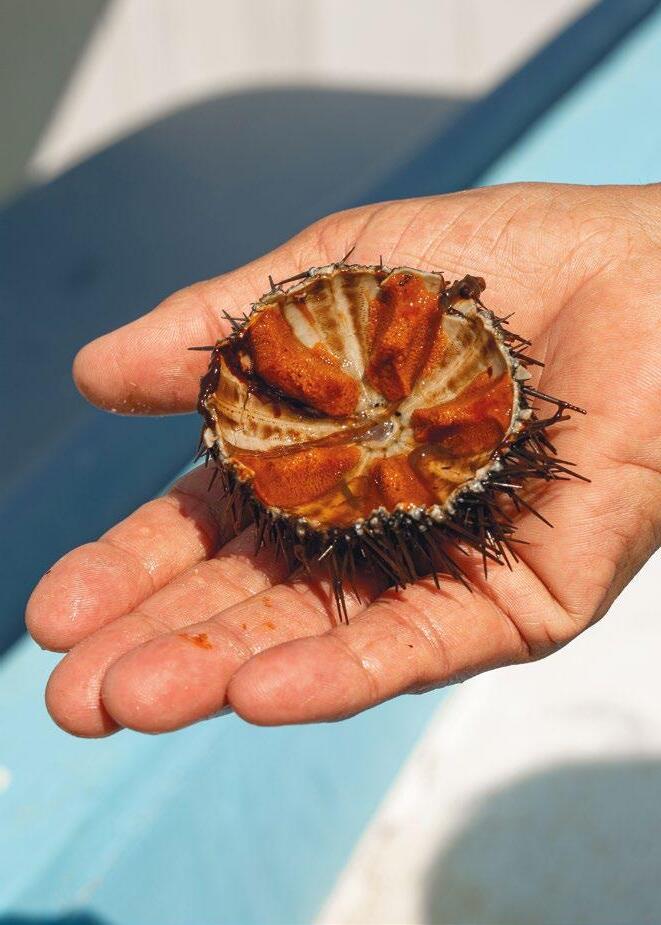
Un riccio di mare aperto e pronto per essere mangiato.
A fresh sea urchin open and ready to be eaten.
Una scena dal film
Ti mangio il cuore (2022), regia di Pippo Mezzapesa, girata nella
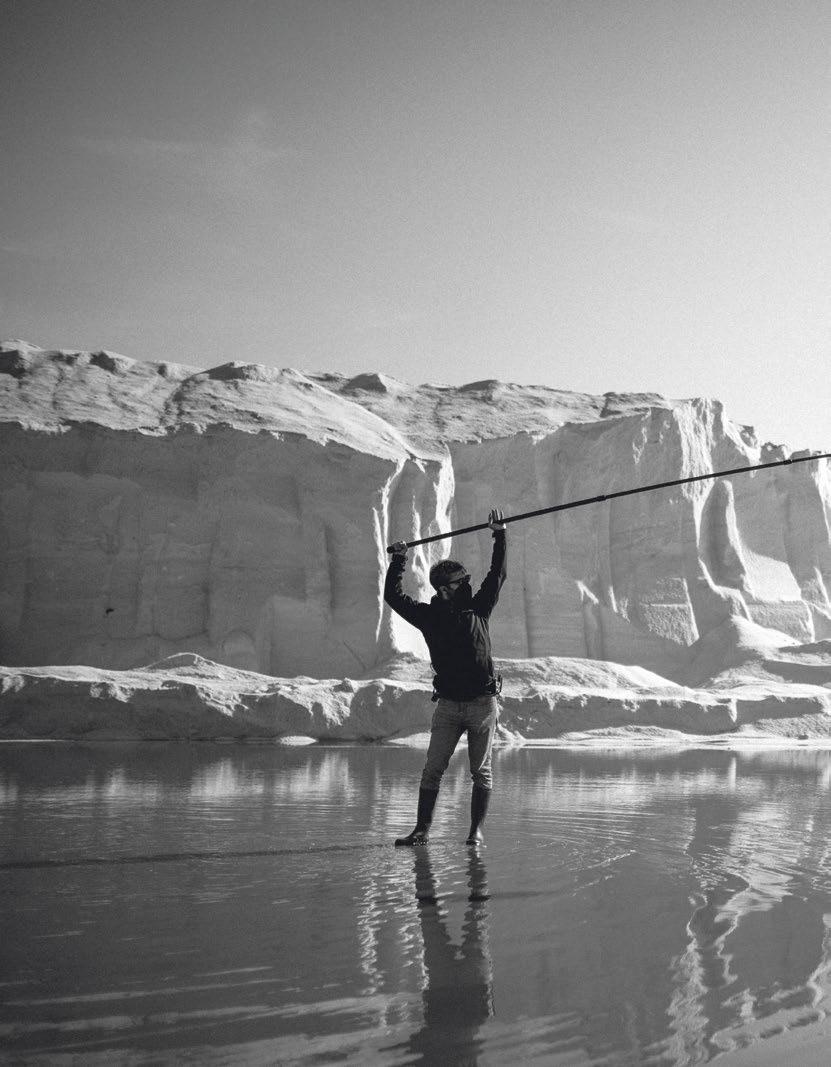
A scene from the film
‘Ti mangio il cuore’ (2022),
Salina di Margherita di Savoia.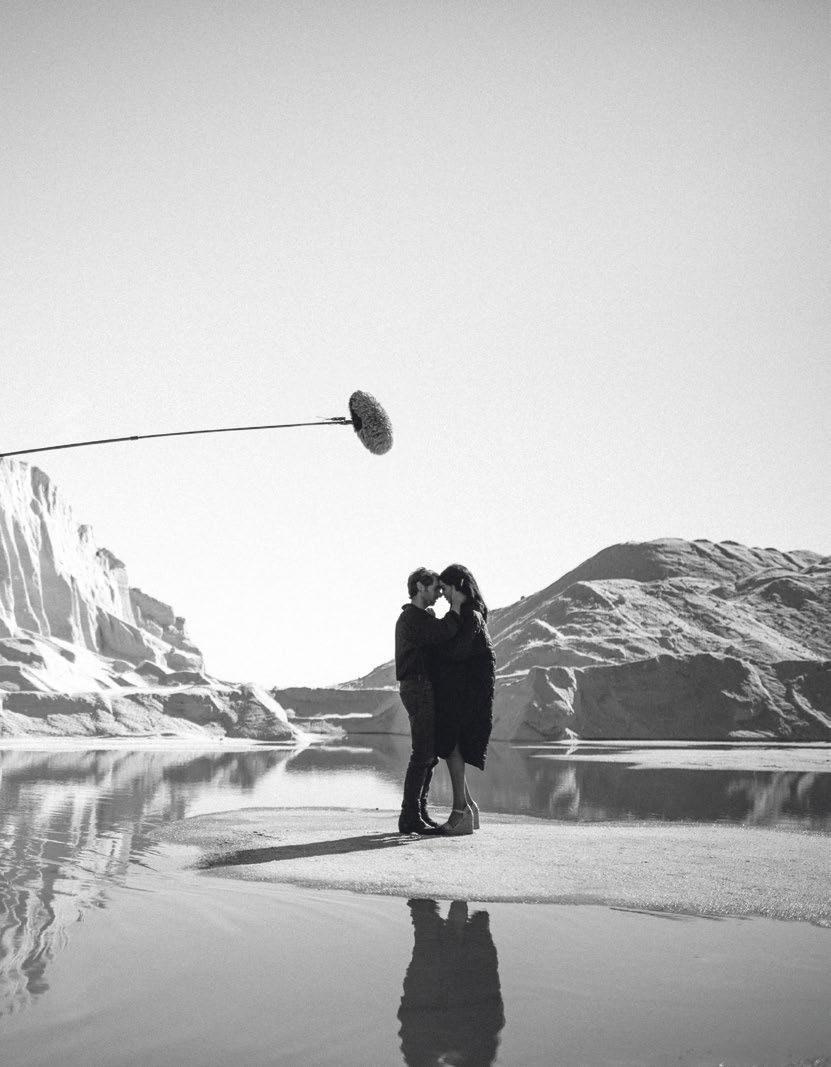
Lights, Camera, Puglia!
¬ Oscar IarussiQUESTA REGIONE NON È SOLO UNA LOCATION MAGNIFICA PER FILM E SERIE TV. È UN TEATRO DI POSA ALL’ APERTO E LA SUA BELLEZZA È ORA SUGLI SCHERMI DI TUTTO IL MONDO
The region is not only a magnificent location for films and TV shows but also an outdoor stage whose beauty can be seen on screens all over the world
Sono trascorsi quasi trent’anni, ma è difficile dimenticare I ponti di Madison County di Clint Eastwood (1995). Al clou della love story, il nome di Bari affiora come un rimpianto sulle labbra della casalinga italoamericana dell'Iowa, Meryl Streep, innamoratasi perdutamente di un fotografo di passaggio nella contea, interpretato dallo stesso Eastwood. Poi in Space Cowboys (2000), Clint mostra la Puglia «in primo piano» dall’alto dello shuttle degli anziani astronauti: nitida lingua di terra nel blu mediterraneo, sidereo omaggio – disse – al paese di Sergio Leone, che aveva trasformato un anonimo cowboy in una star con Per un pugno di dollari (1964). Nelle scorse settimane, di certo memore delle evocazioni paterne, è sbarcato in Puglia l’attore Scott Eastwood, nel cast del thriller Stolen Girl con Kate Beckinsale e James Cromwell, girato tra Brindisi, Lecce e Taranto. Sempre nel Salento sono in corso le riprese di Under the Stars della regista statunitense Michelle Danner, una commedia romantica con Andy Garcia.
Un autentico bagno di folla ha festeggiato nel settembre 2023 l’arrivo di Sylvester Stallone a Gioia del Colle, il paese di cui era originario il nonno Silvestro. C’è una salda relazione tra il cinema americano e la Puglia, anche grazie ad altri oriundi come Brian De Palma (di Alberona), Joe Mantegna (di Acquaviva delle Fonti) e John Turturro (di Giovinazzo) che più volte ha fatto ritorno nella terra avita.
Ma forse la prima diva a «scoprire» la Puglia fu Liz Taylor durante le riprese di Il giovane Toscanini di Franco Zeffirelli al teatro Petruzzelli di Bari (1988). Qui non è Hollywood, recita il titolo di un’attesa serie Disney+ diretta dal pugliese Pippo Mezzapesa sul caso Sarah Scazzi dell’estate 2010 ad Avetrana. Per certi versi è un paradosso nella regione che da una ventina d’anni in qua brilla sugli schermi più di ogni altra. «La Puglia? Per me non è solo una location, è un teatro di posa a cielo aperto», dice Sergio Rubini, popolarissimo attore e regista nato a Grumo Appula, in provincia di Bari. Dal suo
esordio dietro la macchina da presa con La stazione (1990) fino a Il grande spirito (2019), Rubini ha raccontato il riscatto di un’Italia minore e tuttavia forte di valori come la semplicità e il disincanto. La stazione fu il viatico della Fandango Film del barese Domenico Procacci, affermatosi come uno dei produttori più fantasiosi e coraggiosi con film come Gomorra di Matteo Garrone e la serie tv L’amica geniale
Nel Salento, «il sud del sud dei santi» di Carmelo Bene, voce potentissima del teatro e del cinema, è cresciuto il cosmopolita Edoardo Winspeare che narra la parabola poetica di finis terrae in film quali Pizzicata, In grazia di Dio e La vita in comune. Ma questa zona balza sugli scudi anche con Mine vaganti e Allacciate le cinture di Ferzan Ozpetek, attirando il premio Oscar Helen «The Queen» Mirren, che ha acquistato una masseria del XVI secolo nei pressi di Tiggiano con il marito regista Taylor Hackford. Così, in Puglia il cinema si è rivelato un formidabile volano per il turismo dei CONTINUA >
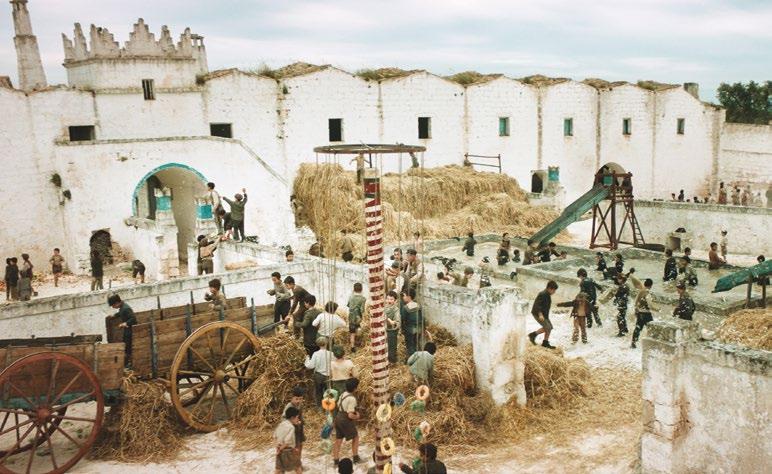
Nearly 30 years later, it’s hard to forget “The Bridges of Madison County” by Clint Eastwood (1995). In a key moment in the love story, Meryl Streep’s Italian American housewife from Iowa – who falls madly in love with a photographer on a brief trip to the county, played by Eastwood himself – regretfully mentions Bari. Subsequently, Puglia could clearly be seen when the ageing astronauts were in the shuttle in “Space Cowboys” (2000). Clint said that the view of the strip of land in the blue Mediterranean was a tribute to the homeland of Sergio Leone, who made the little-known cowboy actor into a star with “A Fistful of Dollars” (1964). No doubt mindful of his father’s memories, in recent weeks actor Scott Eastwood arrived in Puglia as part of the cast for thriller “Stolen Girl” with Kate Beckinsale and James Cromwell, which is being filmed in Brindisi, Lecce and Taranto. American director Michelle Danner is also currently in Salento shooting “Under the Stars”, a romantic comedy starring Andy Garcia.
Sylvester Stallone was greeted by huge crowds in September 2023 when he went
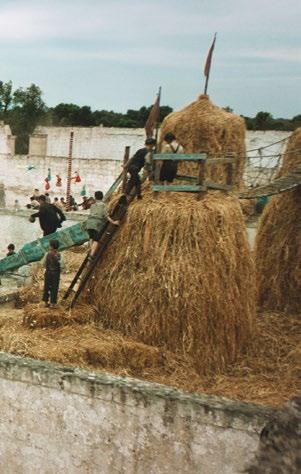
to Gioia del Colle, the town his grandfather Silvestro came from. There are strong ties between Puglia and the US film industry, thanks in part to other people with roots in the region such as Brian De Palma (Alberona), Joe Mantegna (Acquaviva delle Fonti) and John Turturro (Giovinazzo), who has visited a number of times. The first film star to “discover” Puglia might have been Liz Taylor during shooting for “Young Toscanini” by Franco Zeffirelli at the Petruzzelli theatre in Bari (1988).
“Qui non è Hollywood” is the name of a forthcoming Disney+ series by Puglian director Pippo Mezzapesa about the case of Sarah Scazzi in Avetrana in summer 2010. The sad tale is in stark contrast with the general situation in a place that’s shone on screens more than any other Italian region in the last two decades. “Puglia? It’s more than just a location to me: it’s an outdoor studio facility,” says Sergio Rubini, a hugely popular actor and director who was born in Grumo Appula, in the Province of Bari. From his debut behind the camera with “The Station” (1990) and “Il grande spirito! (2019),
Rubini has portrayed the redemption of a side of Italy that might be “humble” but can nonetheless count on values such as simplicity and level-headedness. “The Station” was the first feature produced by Fandango Film, founded by Bari’s Domenico Procacci. He’s proved to be one of the boldest and most imaginative producers around, with films such as “Gomorrah” by Matteo Garrone and the series “My Brilliant Friend”.
Salento was called “the South of the South of saints” by Carmelo Bene, a powerful voice in the worlds of theatre and film. The cosmopolitan Edoardo Winspeare grew up there and presents poetic parables of the end of the Earth in films such as “Pizzicata”, “Quiet Bliss“ and La vita in comune. The area is also celebrated in “Loose Cannons” and “Fasten Your Seatbelts” by Ferzan Ozpetek. It’s attracted Oscar winner Helen “The Queen” Mirren, who bought a 16th century farm near Tiggiano with her husband, Oscar winner director Taylor Hackford. In Puglia, films have been a powerful driving force for CONTINUES >
A sinistra, le riprese di Pinocchio (2019), regia di Matteo Garrone, in una masseria nella Valle d'Itria. A destra, Sophia Loren in una scena del film La vita davanti a sé (2020), diretto dal figlio Edoardo Ponti.
On the left, a shot from the set of ‘Pinocchio’ (2019), directed by Matteo Garrone, filmed at a farmhouse in the Itria Valley. On the right, Sophia Loren in a scene from the film 'La vita davanti a sé' (2020), directed by her son Edoardo Ponti.
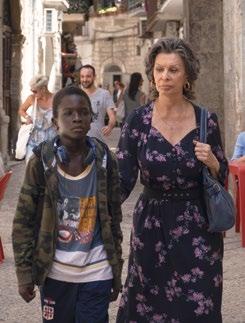
Il cinema si è rivelato un formdabile volano per il turismo delle masserie, delle splendide coste, dei borghi e delle città
Films have been a powerful driving force for tourism in the masserie, stunning coastal areas, villages, towns and cities
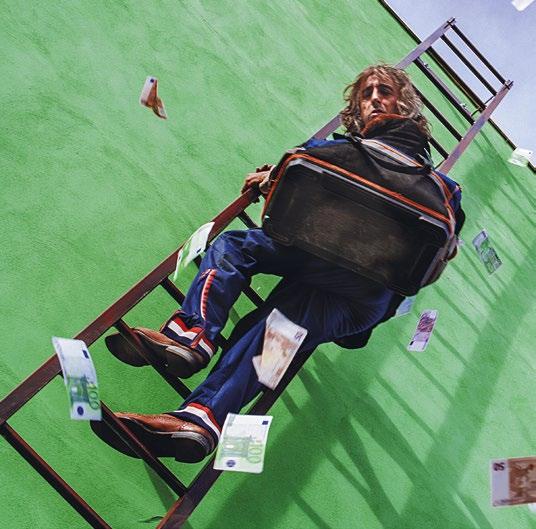
resort esclusivi, delle masserie fortificate, delle splendide coste, dei borghi e delle città. Da ultimo, si pensi all’«effetto Lolita Lobosco» che sta investendo Bari e Monopoli grazie alla fortunata fiction di Rai Uno tratta dai romanzi di Gabriella Genisi, protagonista Luisa Ranieri.
Il cambio di stagione si annuncia con l’approdo della Vlora nel porto di Bari l’8 agosto 1991: ventimila albanesi in fuga dal regime comunista e con lo sguardo proiettato verso Lamerica, titolo del capolavoro di Gianni Amelio (1998). I riflessi dell’esodo si colgono parimenti nei film di Daniele Vicari e Roland Sejko, e nelle intense pagine del filosofo Franco Cassano e di don Tonino Bello, nonché degli scrittori Gianrico e Francesco Carofiglio, Nicola Lagioia, Antonella Lattanzi, Chicca Maralfa, Marco Ferrante... Ne parla pure Susan Sontag, che nei suoi
ultimi anni soggiornò a Bari. La Puglia diventa una frontiera e il cinema – si sa – festeggia lungo le frontiere, là dove Lacapagira, proverbiale titolo di Alessandro Piva (1999), spericolato viaggio negli inferi baresi ed esordio di una interessante filmografia.
La Apulia Film Commission, varata nel 2007 e ora presieduta da Anna Maria Tosto e diretta da Antonio Parente, offre un contributo essenziale. Intanto scalano le vette del box office i film diretti da Gennaro Nunziante e interpretati da Checco Zalone, che rielaborano la tradizione comica dei meridionali in trasferta tipica di Totò, Peppino De Filippo e del campione pugliese Lino Banfi.
A Castel del Monte e dintorni Matteo Garrone ambienta Il racconto dei racconti tratto da Giambattista Basile ed è subito Favoliere delle Puglie.
Mentre richiama produzioni persino da Bollywood, la Puglia continua a essere matrice e ritorno per Michele Placido, Michele Mirabella, Renzo Arbore, Maurizio Sciarra e per talenti come Riccardo Scamarcio, Michele Riondino, Fabrizio Gifuni e tantissimi altri. D’altronde, era originario di Castellaneta il divo dei Due Mondi Rodolfo/Rudy Valentino, cui dedicò un film il compianto Nico Cirasola, già autore di Focaccia Blues sulla rivolta della Murgia contro il mcfood a Gravina in Puglia (set dell’ultimo 007, No Time to Die). Senza dimenticare che a Bari è nata la stella di Monica Bellucci in La riff a di Francesco Laudadio (1991), fratello di Felice, ideatore del Bari International Film Festival. Insomma… Ciak, la Puglia!

tourism in exclusive resorts, masserie, stunning coastal areas, villages, towns and cities. One recent example is the “Lolita Lobosco effect” in Bari and Monopoli, thanks to the successful Rai Uno TV drama starring Luisa Ranieri, which is based on the novels of Gabriella Genisi.
The harbinger of changes to come was the arrival of the ship Vlora in Bari port on 8 August 1991: 20,000 Albanians fleeing the communist regime were aiming to get to “Lamerica”, the title of Gianni Amelio’s masterpiece (1994). The impact of the exodus can be seen in films by Daniele Vicari and Roland Sejko, and in powerful pages by philosopher Franco Cassano and Tonino Bello, as well as the writers Gianrico and Francesco Carofiglio, Nicola Lagioia, Antonella Lattanzi, Chicca Maralfa, and Marco Ferrante. It was also mentioned by Susan Sontag, who stayed in Bari towards the end of her life. Puglia has become one of the frontiers of which the film world is
so fond. Take “Lacapagira” (1999), which marked the start of director Alessandro Piva’s interesting career and plunged viewers into the Bari underworld.
A key contribution is made by the Apulia Film Commission, which was launched in 2007 and now has president Anna Maria Tosto and general manager Antonio Parente at the helm. Meanwhile, director Gennaro Nunziante’s box office smashes starring Checco Zalone present a fresh take on the comic tradition of travelling southerners associated with Totò, Peppino De Filippo and Puglian legend Lino Banfi. Matteo Garrone chose Castel del Monte and the surrounding area as locations for “Tale of Tales”, based on Giambattista Basile’s fairy tales. Puglia is now even attracting Bollywood productions, while continuing to provide strong roots and see the return of Michele Placido, Michele Mirabella, Renzo Arbore, Maurizio Sciarra and countless talents such as Riccardo
Sergio Rubini in una scena di Il grande spirito (2019), film da lui diretto girato a Taranto.
Sergio Rubini in a scene from ‘Il grande spirito’ (2019), a film he directed, shot in Taranto.
Scamarcio, Michele Riondino and Fabrizio Gifuni. The original “Latin Lover” Rudolph Valentino was from Castellaneta. The late Nico Cirasola made a film about him, as well as Focaccia Blues: a documentary about Murgia’s anti-McDonald’s movement in Gravina in Puglia (a place seen in the latest Bond film, No Time to Die). Monica Bellucci’s film career also began in Bari with “The Raffle“ by Francesco Laudadio (1991), whose brother Felice came up with the idea for Bari International Film Festival. So... Lights, Camera, Puglia!
In Praise of Slowness
¬ Luca BergaminEnglish artist Jared Green has found in the Itria Valley both a sense of time and his source of inspiration

Jared Green nella sua Villa Itria, Cisternino.
Jared Green in his Villa Itria, Cisternino.
«Qui in Puglia, io pratico la gratitudine per la luce, l’energia, il cielo, la cultura antica, i grandi spazi. Ho ricreato me stesso creando contemporaneamente arte. Al punto che non riesco più a immaginarmi in altro luogo al mondo». Incontrare Jared Green, interior designer e artista visuale nato nel 1980 nello Staffordshire in Inghilterra, significa lasciarsi attraversare dalla gioia genuina di un uomo che dopo aver fatto il bancario, lo stilista per lo star system britannico e l’interior designer, ha finalmente incontrato la luce che inconsciamente cercava in Valle d’Itria.
Il matrimonio con la Puglia è cominciato proprio da un matrimonio…«All’epoca avevo uno studio a Londra dove esponevo i miei dipinti per le case che progettavo. Potevo ritenermi soddisfatto, eppure sentivo che mi stava sfuggendo il senso del tempo, la sostanza più profonda, la materia della vita. L’ho capito mentre ero in Puglia per il matrimonio di una coppia di amici. Mi sono bastati tre giorni per legarmi per sempre alla Valle d’Itria. Giravo in bicicletta per ore e ore seguendo la scia della luce da Cisternino all’Adriatico».
"In Puglia, I practise gratitude for the light, the energy, the sky, its ancient culture, the wide spaces. I have recreated myself while simultaneously creating art, to the point where I can no longer imagine being anywhere else in the world." Meeting Jared Green, an interior designer and visual artist born in 1980 in Staffordshire, England, means experiencing the genuine joy of a man who, after being a banker, a designer for the British star system, and an interior designer, finally encountered the light he was unconsciously seeking in the Itria Valley,
His union with Puglia began with a wedding…"At that time, I had a studio in London where I displayed my own paintings for the homes I designed. I could consider myself satisfied, yet I felt I was losing the sense of time, the deeper substance, the matter of life. I realised this while in Puglia for the wedding of a couple of friends. It took just three days for me to forever bind myself to the Itria Valley. I rode my bicycle for hours on end, following the trail of light from Cisternino to the Adriatic."
But destiny, and the Puglian olive trees, were just around the corner. "I fell in love at first sight with this
Il destino, però, e gli ulivi pugliesi erano dietro l’angolo. «Mi sono innamorato a prima vista di questa terra, ho percepito la sua natura selvaggia, la forza del mare, la potenza del sole. Ho capito che dovevo seguire quella sensazione di appartenenza, ma dovevo farlo in fretta, prima che la Brexit bloccasse tutto. Ho preso una casa nella campagna di Locorotondo, con spazi per dipingere ed esporre le mie opere sotto quello sfrontato cielo azzurro e dentro quella macchia infinita di ulivi prima del mare».
Villa Itria, la sua casa, è diventata anche un progetto estetico, una delle sue opere d'arte. «Le ho trasmesso il mio stile. È una vetrina della mia ricerca mirata a catturare l’essenza del tempo che scorre. L’argilla, lo stucco, gli elementi vegetali che impiego nei dipinti e nelle installazioni dentro le stanze esprimono la tangibilità dell’esistenza. La Puglia ispira l’arte».
Nelle grandi città sembra svanita quella lentezza e quella cura che servono per assorbire una cultura millenaria come quella pugliese. «Nelle metropoli questo patrimonio di saggezza è stato esautorato dalla velocità del nuovo. Io qui impazzisco per la sensazione di avere la terra intorno a me e sentire il canto degli uccelli. Adoro le luci e le ombre che fanno l’amore davanti ai miei occhi, e sono grato per le possibilità immense che questi spazi offrono. Quell’ettaro di terra che circonda Villa Itria mi sembra una grande tela. Io ci vedo qualcosa di profondo e ancestrale, un intreccio tra il passato e il futuro della Puglia che ha abbracciato il cambiamento portato dagli stranieri che, come me, la amano, senza rinunciare alla sua storia, al suo temperamento, alla sua sincerità».
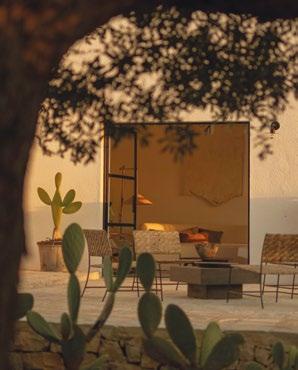
land; I sensed its wild nature, the strength of the sea, the power of the sun. I knew I had to follow that feeling of belonging, but I had to act quickly before Brexit could block everything. I bought a house in the countryside of Locorotondo with space to paint and exhibit my works under that bold blue sky and within that endless stretch of olive trees before the sea."
Villa Itria, his home, has also become an aesthetic project, a work of his art. "I have imparted my style to it. It is a showcase of my quest to capture the essence of flowing time. The clay, the plaster, the plant elements I use in the paintings and installations within the rooms express the tangibility of existence. Puglia inspires art."
In big cities, the slowness and care needed to absorb a millennia-old culture like that of Puglia seem to have vanished. "In cities, this heritage of wisdom has been ousted by the speed of the new. Here, I am crazy about the feeling of having the earth around me and hearing the birds sing. I adore the lights and shadows that make love before my eyes, and I am grateful for the immense possibilities these spaces offer. That hectare of land surrounding Villa Itria seems like a grand canvas to me. I see something profound and ancestral, a weave between the past and the future of Puglia that has embraced the change brought by foreigners like me who love it without giving up its history, its temperament, its sincerity."
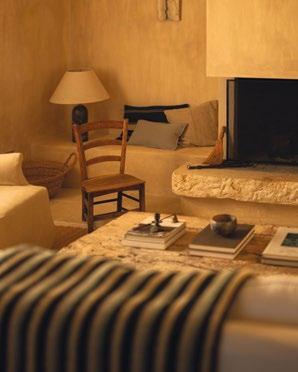
They Look so Good, You’ll Want to Eat Them
¬ Marta Ghelma
RADICI SALDE E MENTE APERTA, MARTINO RUBINO, CREA PIZZI, MERLETTI, POMODORI E PEPERONCINI IN CERAMICA CHE SEMBRANO VERI
With solid roots and an open mind, Martino Rubino creates ceramic lace, tomatoes and chilli peppers that look like the real thing
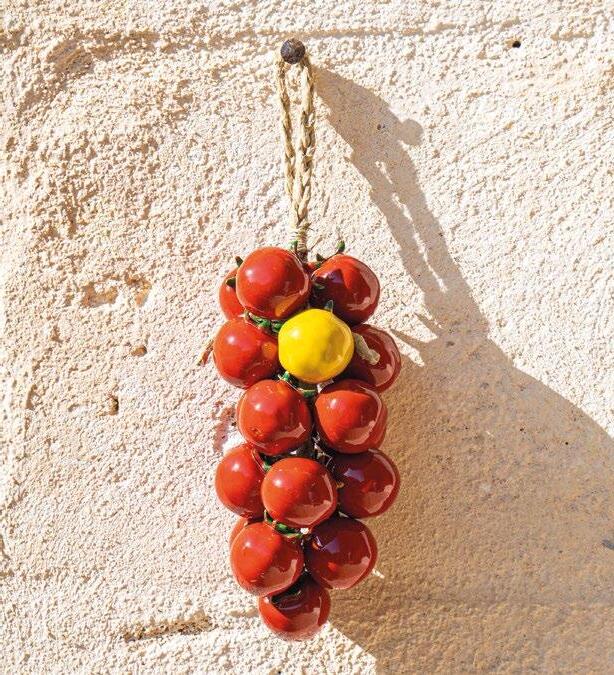
Le ramasole, pomodorini tipici della zona di Fasano.
Pagina accanto, Martino Rubino nel suo laboratorio.
Ramasole, typical cherry tomatoes from Fasano.
Opporiste page, Martino Rubino in his atelier.
«In un certo senso, la pittura è un'arte “egoista” perché sulla tela dipingi ciò che senti tu, mentre l'artigianato è per sua stessa natura più “altruista” perché crea qualcosa per soddisfare il cliente. In più c’è una dose di fantasia». È il pensiero di Martino Rubino, 62 anni, che dopo vent’anni in giro tra Centro America, Oriente e Italia, ha deciso di tornare nella sua Puglia, dove ha aperto due laboratori artigianali Domus Artis, uno a Fasano e uno a Pezze di Greco.
«Io preferisco definirmi artigiano. Mi piace lavorare con le mani e realizzare ciò che ho in mente, cercando sempre di migliorare. Viaggiare mi è servito moltissimo. Non solo a osservare forme nuove e a utilizzare l’argilla in modo diverso, ma anche ad aprirmi a un “dialogo” più internazionale».
La ceramica tradizionale pugliese è nata bianca per soddisfare gli usi quotidiani (piatti, pentole e capasoni, i vasi per conservare olio, vino e acqua), si è offerta al turismo con i pumi (i famosi boccioli portafortuna) e si è evoluta poi nell'artigianato artistico. Tra i mini-capolavori di Martino, compaiono merletti, pizzi, collane di peperoncini, rami di ulivo e i pomodori Regina, un’eccellenza della zona di Fasano, così ben fatti da sembrare veri quando li vedi appesi a grappoli, come si fa con quelli veri nelle masserie pugliesi.
«Il bello della ceramica è che si può praticare ovunque, così ho scelto di tornare nella mia Puglia, dove la creatività è straordinaria. Ma se oggi riesco a modernizzare la produzione pur restando saldo alla tradizione, è grazie all’apertura mentale che ho acquisito viaggiando lontano da qui».
Martino proviene da una famiglia di contadini –«generosi, amorevoli e intelligenti», racconta – che lo hanno sempre spinto a seguire la sua passione e la sua vocazione. E a chi gli chiede cosa pensi delle mode in voga nella ceramica pugliese contemporanea, lui in un attimo torna a focalizzarsi sulla tradizione. Per gusto personale e per rispetto alle sue radici.
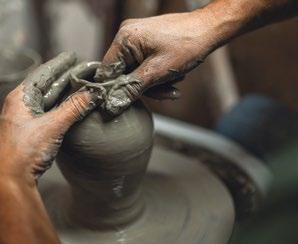
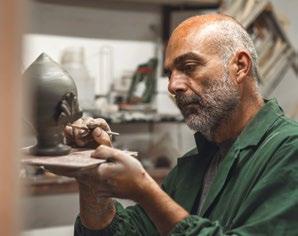
“Painting is a 'self-centred’ art because on the canvas you paint what you personally are feeling. In contrast, crafts are inherently more ‘altruistic’: you’re making something first and foremost to satisfy your customer, with a dash of imagination.”
62-year-old Martino Rubino spent a long time in Central America, the East and other parts of Italy. Around 20 years ago he decided to return to his homeland in Puglia, where he opened two Domus Artis craft workshops: one in Fasano and one in Pezze di Greco.
“I don’t like to call myself an artist. I prefer to say that I’m an artisan who likes to work with his hands and make what he has in mind, striving to improve. Travelling really helped me. Not only to notice new shapes and to use clay in a different way, but also to open up to a more international dialogue.”
Traditional Puglian ceramic ware was originally white and came in forms catering to everyday needs. It opened up to tourism with «pumi» (the famous lucky buds) and evolved to include artistic craft creations. Martino’s ceramic mini-masterpieces include lace, chilli pepper necklaces, olive branches and the exceptional round Regina tomatoes. He recreates them so faithfully that they look real.
“Even seemingly simple things take on fresh value and have a whole new feel to them when they’re made out of ceramics using the traditional technique. The wonderful thing about this art is that you can do it anywhere, so I decided to return to Puglia, an incredibly creative region. But if today I am able to modernise production while remaining steadfast to tradition, it is because of the open-mindedness I have gained from travelling far away.”
Martino comes from a family of farmers that he describes as “generous, loving and intelligent”. They always encouraged him to follow his passion. If you ask him what he thinks of the new fashions that are so popular in contemporary Puglian pottery, he’ll instantly shift the focus back to tradition, due to both his personal taste and his respect for his roots.
Art is a Serious Game
¬ Giuseppe Fantasia ¬ Ph. Marino Colucci
SALE BIANCHE CON VISTA MARE E OGGETTI SCULTOREI EXTRA LARGE. LA FONDAZIONE PINO PASCALI È UN OMAGGIO A UN GRANDE ARTISTA E ALL’ARTE CONTEMPORANEA
White rooms with sea views and extra-large sculptural objects. The Pino Pascali Foundation is a tribute to a great artist and to contemporary art
Ribelle, indipendente, imaginifico. Le sue opere erano i «giochi» con cui guardava e viveva il mondo, una realtà che contestava con labbra rosse – si pensi al suo Omaggio a Billie Holiday, 1964 – e armi costruite con materiali di recupero, falsamente minacciose perché inutilizzabili, come il Cannone Semovente e Bella Ciao, entrambe del 1965. Pino Pascali è stato probabilmente il più grande artista pugliese del Novecento, sicuramente uno dei più noti a livello internazionale con opere anche alla Tate Modern di Londra, al Centre Pompidou di Parigi e al Museum of Modern Art di New York. Quando morì l’11 settembre del 1968 a causa di un incidente in moto, si interruppe prematuramente (aveva solo 33 anni) una prolifica carriera. Pascali era nato a Bari (nel 1935), ma la sua famiglia era di Polignano a Mare, dove erano conservati, ma non esposti, molti suoi lavori, spesso di grandi dimensioni. Meritavano uno spazio, così il Comune ha realizzato nell’ex mattatoio comunale la «stanza tutta per sé» con vista sul mare che l’artista avrebbe sempre voluto, una struttura chiara e luminosa al centro di quella natura che considerava «una madre profonda e benigna, dispensatrice di vita e di erotismo».
Nelle ampie sale sono esposte le sue «finte sculture», oggetti d’arte in cui gli elementi naturali si trasformano in opere surreali e ironiche: La Vedova Blu (1965), i dinosauri, le balene, i delfini, i pescecani, i rettili. Fantastico e realtà sono il filo conduttore anche di Campi arati, Canali d’irrigazione, 1mc di terra, e dello scenografico 32 mq di mare, un lavoro realizzato con vaschette di zinco piene di acqua, per conciliare il naturale con l’artificiale, e prendere coscienza contro l’urbanizzazione e il tecnologismo avanzante. «Da lontano, le opere di Pascali sembrano dei ready-made, ma a uno sguardo ravvicinato si capisce che sono state realizzate con materiali di recupero, come bitume, latte, metallo, legno, piumini per la polvere», dice Mark Godfrey, curatore della monografica sull’artista attualmente alla Fondazione Prada di Milano (fino al 23 settembre 2024). E lo noterete anche voi. Il suo è un mondo reinventato, questo è sicuro, ma è soprattutto il libero gioco di un artista-bricoleur che cercava di fare solo quello che gli piaceva.
Rebellious, independent, imaginative. His works were the “games” with which he viewed and experienced the world, a reality he challenged with red lips – think of his Homage to Billie Holiday, 1964 – and weapons made from salvaged materials, falsely menacing because they were unusable, like the Cannone Semovente (Self-propelled Cannon) and Bella Ciao, both from 1965. Pino Pascali was probably the greatest Puglian artist of the twentieth century, certainly one of the most internationally renowned, with works at the Tate Modern in London, the Centre Pompidou in Paris, and the Museum of Modern Art in New York. When he died on 11 September 1968 in a motorcycle accident, a prolific career was prematurely cut short (he was only 33). Pascali was born in Bari (in 1935), but his family was from Polignano a Mare, where many of his often large-scale works were kept but not displayed. They deserved a space, so the town created in the former municipal slaughterhouse the “room of his own” with a sea view that the artist had always wanted, a bright and airy structure at the heart of the nature he considered “a profound and benevolent mother, dispenser of life and eroticism.”
In the spacious rooms, his “fake sculptures” are on display, artworks where natural elements are transformed into surreal and ironic creations: ‘La Vedova Blu’ (Blue Widow) (1965), dinosaurs, whales, dolphins, sharks, and reptiles. Fantasy and reality are the common thread in ‘Campi arati’, ‘Canali d’irrigazione’ (Ploughed Fields and Irrigation Ditches), ‘1mc di terra’ (One Cubic Metre of Earth), and the scenographic ‘32 mq di mare’ (32 Cubic Metres of Sea), a work made with galvanised aluminium tubs filled with water to reconcile the natural with the artificial and raise awareness against urbanisation and advancing technology. “Works that looked from a distance like readymades revealed themselves close-up to be constructed from found materials like bitumen, tins, metal, wood, dusters,” wrote Mark Godfrey, curator of the artist’s retrospective currently at the Fondazione Prada in Milan (until 23 September 2024). And you will notice it too. Pascali’s world is a reinvented one, this much is certain, but above all, it is the free play of an artist-bricoleur who sought to do only what he loved.

Sopra, la vista dalle vetrate della Fondazione Pino Pascali. Sotto, Cinque bachi da setola e un bozzolo (2012), Pino Pascali.
Above, the view from the windows of the Pino Pascali Foundation. Below, ‘Cinque bachi da setola e un bozzolo’ (2012) by Pino Pascali.
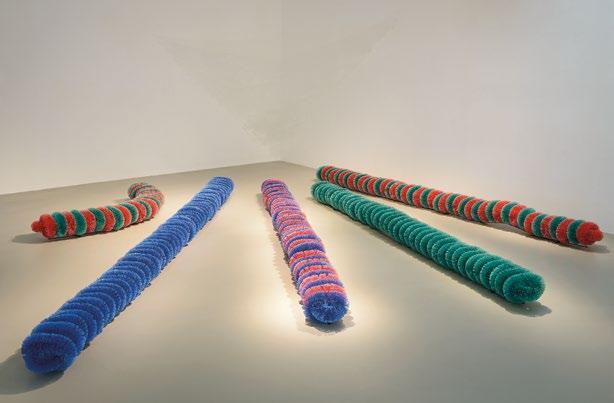
LA MUSICA PUGLIESE È PIÙ VIVA CHE
MAI. E UN MOTIVO C’È: SI ELABORA LA TRADINNOVAZIONE, SI CANTA IN BRINGLISH
E SI SUPERANO I CONFINI INTERNAZIONALI RACCONTANDO LE ORIGINI
The Puglian music scene has never been so vibrant, thanks to a blend of tradinnovation, singing in Bringlish and stories about the region’s roots that reach beyond international borders
A destra, una foto dalla Notte della Taranta. Il suono del tamburello ha reso la pizzica famosa in tutto il mondo.
On the right, a photo from Notte della Taranta. The sound of the tambourine has made the pizzica famous worldwide.
Melpignano, profondo Salento. Coltivazioni di tabacco perse tra ulivi secolari. Muri a secco, pozzi, colombaie e frantoi. Se si cerca la Mecca della musica pugliese non si può che partire da qui. Da un borgo che è la New Orleans della pizzica, la musica che scandiva l’antico rituale di cura dal morso immaginario della tarantola, un pericoloso ragno velenoso. Dal 1998, ogni anno, La Notte della Taranta porta a Melpignano musicisti di fama nazionale e internazionale. Il Louis Armstrong pugliese è Uccio Aloisi. Con il tamburello al posto della tromba,
ha trasmesso il verbo della pizzica a uno stuolo di musicisti che l’hanno declinata secondo i gusti del terzo millennio, ed esportata oltre i confini italiani. È il caso dei Mascarimirì, che con la loro electro-pizzica sono stati tra i protagonisti, a Marsiglia, dell’ultima Babel Med, una delle più prestigiose rassegne di musiche del mondo. La loro storia è il ponte ideale tra il passato e la proiezione nel futuro. Negli anni hanno dato vita al concetto di tradinnovazione, un melting pot dove la tipica musica salentina cambia volto e si confronta con altre sonorità: dal

dub al reggae, dal rock all’hard-core. Un’innovazione dal sound potente e coinvolgente, battezzata “punkhard-core-tarantolato salentino”, che evidenzia l’innesto nel patrimonio tradizionale di tecniche fino ad allora estranee alle sonorità popolari.
Amante dell’innovazione, nel rispetto della tradizione, è anche la leccese Maria Mazzotta, un’artista che si è messa in proprio nel 2015 dopo una prestigiosa militanza nel Canzoniere Grecanico Salentino, band che con le sue canzoni è da tempo
CONTINUA >

Melpignano, in deepest Salento. Tobacco grows among age-old olive trees. Drystone walls, wells, dovecotes and oil mills. If you’re looking for the Mecca of Puglian music, this is the only place to start. The town is the New Orleans of pizzica: the music that was played during ancient rituals performed in an attempt to cure imaginary bites by dangerous, venomous tarantulas. Since 1998, La Notte della Taranta has brought nationally and internationally renowned musicians to Melpignano every year. Uccio Aloisi was the Puglian Louis Armstrong. Playing a tambourine instead of a trumpet, he spread
the word about pizzica to a multitude of musicians, who have brought it in line with the tastes of the 21st century and taken it beyond Italy’s borders. For example, take Mascarimirì. With their electro-pizzica, they were in the spotlight at the last Babel Med in Marseille, which is one of the most prestigious music festivals in the world. Their story builds the ultimate bridge between the past and the future. Over the years, they’ve developed the concept of tradinnovazione (tradinnovation): a melting pot that changes the face of typical music from Salento and brings on board other sounds, from dub and reggae to
rock and hardcore. Known as “punk-hardcore-tarantolato salentino”, the innovative approach has a powerful, engaging sound and complements traditional heritage by introducing techniques that are new to music of this kind.
Another lover of innovating while staying true to tradition is Maria Mazzotta from Lecce. She went solo in 2015 after many prestigious years with Canzoniere Grecanico Salentino, a band whose songs have long been part of the playlist on the web radio presented by David Byrne, a founding member of Talk- CONTINUES >
Il ritmo ancestrale della pizzica conserva la sua funzione catartica che, con i valori che si porta dietro, può diventare un messaggio di speranza
The ancient rhythm of the pizzica retains its cathartic role and –with its inherent values – brings a message of hope
presente nella playlist della web radio di David Byrne, fondatore dei Talking Heads. Recentemente la Mazzotta ha lavorato con il catalano Raül Refree, uno dei produttori più innovativi d’Europa che, dopo aver reinventato il flamenco con Rosalia e il fado con Lina, ha incontrato la regina del Salento e ne è nato un viaggio vibrante attraverso la musica pugliese. Un altro transfugo del Canzoniere Grecanico Salentino che ha deciso di dare una svolta all’inflazionata febbre della pizzica, senza però rinnegarla, è Antonio Castrignanò. Nativo di Calimera, è sempre stato convinto che il suo ritmo ancestrale può conservare la sua funzione catartica e che, insieme ai valori che si porta dietro, può ancora essere un messaggio di speranza. Grazie alla sua musica si è misurato con la contemporaneità e nei testi delle sue canzoni parla del rapporto tra uomo e natura, dell’amore e del lavoro, dello sfruttamento dei migranti e della condizione femminile. Ha deciso di farlo lavorando con artisti eterogenei: da Ludovico Einaudi a Goran Bregovic e The Chieftains. Un esperimento riuscito, che nel 2022 gli è valso il premio come autore del secondo miglior album nella prestigiosa World Music Charts Europe.
ing Heads. Mazzotta recently worked with the Catalan Raül Refree, one of the most innovative producers in Europe. After reinventing flamenco with Rosalia and fado with Lina, he met the queen of Salento and they went on a vibrant journey through Puglian music. Antonio Castrignanò is another former member of Canzoniere Grecanico Salentino. He saw excessive pizzica-mania and decided to move in a new direction while continuing to espouse it. Born in Calimera, he’s always believed that its ancient rhythm can carry on having a cathartic role and – along with its inherent values – bring a message of hope. Through his music, he has delved into contemporary life. In the lyrics of his songs, he discusses the relationship between people and nature, as well as love, work, exploitation of migrants and the place of women in society. He’s done this by collaborating with a wide range of artists: from Ludovico Einaudi and Goran Bregovic to The Chieftains. It’s proved to be a successful approach and in 2022 it saw his record being named the second best World Music album in the world in the prestigious World Music Charts Europe.
Alea is the stage name of Alessandra Zuccaro, a mezzosoprano from Brindisi who spans the worlds of blues, jazz and soul. Her sensual, refined voice is never overly exuberant but roams freely through notes, dazzlingly travelling up and down. She’s still young but she’s performed in a huge number of concerts, during which she’s been accompanied by figures such as the internationally renowned jazz trumpeter Fabrizio Bosso and Senegalese percussionist Meissa Ndiaye. Alea’s music might be described as MediterraNeoSoul, using a label that sums up the combination of soul music and the culture of Southern Italy, and indeed all the southern parts of the world. A number of fine exponents of this genre can be found in Puglia. Take Taranto-based Mama Marjas (born Maria Germinario). She features on Alea’s latest record singing in Bringlish: a type of grammelot that mixes English with the dialect of Brindisi, showing how musical the Puglian accent is.
Underlining how much the people of Puglia love their cuisine, one of the biggest hits in the last few months has been Ù Baccalà, a song with a pounding, infectious rhythm. Serena Brancale, a singer-songwriter and multi-instrumentalist from
Alea, nome d’arte di Alessandra Zuccaro, è una mezzosoprano brindisina che si muove tra blues, jazz e soul. Una voce la sua, che sa essere sensuale ed educata, mai strabordante ma libera di giocare sulle note e su impervi saliscendi sonori. Nonostante la giovane età ha una chilometrica lista di concerti alle spalle, dove ha trovato il modo di farsi accompagnare anche dalla tromba di Fabrizio Bosso, jazzista di fama internazionale, o dalle percussioni del senegalese Meissa Ndiaye. Quello di Alea può essere chiamato MediterraNeoSoul, un gioco di parole che sottintende l’unione tra la musica soul e la cultura del Sud Italia o, meglio, di tutti i Sud del mondo. Un genere che in Puglia ha più di un valido esponente. Come la tarantina Mama Marjas (all’anagrafe Maria Germinario) che ha una comparsata nel nuovo disco di Alea in bringlish, un grammelot che mischia l’inglese con il dialetto brindisino, dimostrando quanto sia musicale l’accento pugliese. CONTINUA > CONTINUES >


 Antonio Castrignanò ¬ Ph Ray Tarantino
Mundial
Alea
Antonio Castrignanò ¬ Ph Ray Tarantino
Mundial
Alea
A conferma di quanto i pugliesi amino la loro cucina la canzone tormentone che impazza da qualche mese è Baccalà, un brano dal ritmo martellante. Serena Brancale, cantautrice e polistrumentista barese che lo ha firmato, ha confessato: «La canzone è nata perché volevo creare una rima con l’accento. Il baccalà non è proprio il pesce tipico di Bari, polpo crudo non andava bene, ricci col pane neanche...».
Basata sui ritmi è anche la musica dei Mundial, un progetto dei salentini
Carmine Tundo, Roberto Mangialardo e Alberto Manco. Il loro percorso parte dalle radici della musica pugliese e arriva alle nuove frontiere dell’elettronica moderna. Un ponte tra passato e futuro che, dopo aver recuperato le filastrocche dei nonni, le inserisce in un contesto sperimentale, dove c'è spazio anche per i campionamenti dei suoni dei paesaggi pugliesi che, una volta lavorati, vengono trasformati in pattern ritmici.
A cavallo tra il pop e il jazz corre il sound del dj, musicista e compositore barese Nicola Conte. La sua musica si ispira alle atmosfere sonore degli anni Sessanta e Settanta, a cui vengono però aggiunte la bossa nova e una tradizione jazzistica. Non è una novità per la Puglia, una regione che ha una longeva tradizione jazz che vede i suoi prodromi nel virtuosismo di straordinari strumentisti cresciuti nelle bande che da sempre accompagnano le feste popolari.
Ai confini della spiritualità è invece la musica di Michele Labaccaro, compositore e musicista fondatore dei Radiodervish. Le sue canzoni, intense e ricche di poesia, hanno la valenza di un viaggio, tra fantascienza e spiritualità, verso un nuovo orizzonte di libertà nel quale gli esseri umani sono chiamati a imparare a muoversi. L’ennesima conferma che la musica in Puglia non si fa mancare proprio nulla.
Bari who wrote it, confessed, "The song came about because I wanted to create a rhyme with the accent. Baccalà isn’t really a fish typically associated with Bari, but raw octopus didn’t work and neither did urchins with bread..."
Rhythm also forms the musical foundations of Mundial, a project by Carmine Tundo, Roberto Mangialardo and Alberto Manco of Salento. They have followed a path from the roots of Puglian music to the new frontiers of modern electronica. Tying together the past and the future, they take the nursery rhymes of their grandparents and put them into experimental arenas where they also make room to sample the sounds of Puglian landscapes, which they transform into rhythmic patterns.
The sound of Bari-based DJ, musician and composer Nicola Conte straddles pop and jazz. His music is inspired by the sounds of the 1960s and 1970s, to which he adds bossa nova and classic jazz. This is nothing new in Puglia, which has a long-standing jazz tradition. It was heralded by the virtuoso displays of incredible instrumentalists who learned their trades in the bands that have always performed at folk festivals.
Meanwhile, there’s a spiritual side to the music of Michele Labaccaro, the composer, musician and founder of Radiodervish. His profound, extremely poetic songs span the realms of science fiction and spirituality, taking listeners on a journey towards a new horizon of freedom where human beings must learn to move. It’s further proof that you can find absolutely everything on the Puglian music scene.
Fondato nel 1975, il Canzoniere Grecanico Salentino (CGS) innova e rappresenta la musica pugliese nel mondo, collaborando con artisti illustri di fama internazionale.
Founded in 1975, ‘Canzoniere Grecanico Salentino’ (CGS) innovates and represents Puglian music around the world, collaborating with internationally renowned artists.

Scopri la Puglia attraverso una playlist che cattura l'essenza dell’estate mediterranea
Apri la tua app Spotify™, accedi alla sezione «Cerca» e tocca l’icona della macchina fotografica in alto a destra. Scansiona il codice Spotify qui sopra e ascolta i ritmi energici della musica tradizionale pugliese, melodie moderne mediterranee e icone della canzone italiana, in un viaggio sonoro che esalta il calore e il fascino di questa terra unica.
Explore Puglia through a playlist that captures the essence of its Mediterranean summer
Open your Spotify™ app, go to the Search section and tap the camera icon at the top right. Scan this Spotify code and listen to the lively rhythms of traditional Puglian music, modern Mediterranean melodies, and icons of Italian song, on a musical journey that celebrates the warmth and charm of this unique land.

It's All One Big Party!
¬ Carlo Saponaro
I NOSTRI CONSIGLI SU ARTE, DESIGN, MOSTRE, PERFORMANCE ED ESPERIENZE IMMERSIVE DA VIVERE IN PUGLIA DURANTE LA PROSSIMA STAGIONE. UNA SERIE DI APPUNTAMENTI IMPERDIBILI IN UNA TERRA CHE RIEMPIE GLI OCCHI DI BELLEZZA
Our recommendations on art, design, exhibitions, performances, and immersive experiences to enjoy in Puglia during the upcoming season. Events not to be missed, in a land that fills your eyes with beauty
Polifonic Festival
¬ Ph. Vittorio La Fata

RIBALTA
Il Luce Music Festival valorizza i luoghi più belli della Puglia con spettacoli di luce e concerti. Dal 15 giugno.
ROCK&POP
Bari, Fasano, Ostuni e Locorotondo ospitano la XX edizione del Locus Festival, con musica nazionale e internazionale. Dal 28 giugno al 14 agosto.
OPERA
A Martina Franca, il Festival della Valle D’Itria festeggia 50 anni con tre opere: la Norma di Vincenzo Bellini, Aladino e la lampada magica di Nino Rota e Ariodante di Händel. Dal 17 luglio al 6 agosto.
ELECTRO
Il Polifonic Festival esplora vari generi, dal raggamuffin dei Sud Sound System al XLR8R di Tama Sumo, dj resident del Berghain di Berlino. Dal 25 al 28 luglio.
UNDERGROUND
A Locorotondo torna Viva! Festival, appuntamento con la musica elettronica contemporanea. Dall'1 al 4 agosto.
ITINERANTE
Le stelle della musica elettronica sono ospiti anche del Panorama Festival: Peggy Gou, Charlotte de Witte e tanti altri. In diversi borghi del Salento, dall’11 al 17 agosto.
TRADIZIONE
La Notte della Taranta, 27ª edizione celebra la tradizione musicale pugliese con ospiti d’eccezione. Il 24 agosto a Melpignano.
SOGNI
PhEST ravviva Monopoli con fotografia, cinema, musica e arte mediterranea. Il tema di quest'anno è il Sogno. Dal 30 agosto al 3 novembre.
RISPETTO
Lecce e Matino ospitano la quarta edizione di Yeast Photofestival, che unisce fotografia, cibo e arti visive per raccontare il rispetto dell’ambiente e della biodiversità. Dal 19 settembre al 3 novembre.
Luce Music Festival highlights Puglia’s most beautiful locations with light shows and concerts. From June 15.
Bari, Fasano, Ostuni, and Locorotondo host the 20th edition of Locus Festival, with national and international music. From June 28 to August 14.
In Martina Franca, the Festival della Valle D’Itria celebrates 50 years with three operas: Vincenzo Bellini's ‘Norm’a, Nino Rota's ‘Aladino e la lampada magica’, and Händel's ‘Ariodante’. From July 17 to August 6.
Polifonic Festival explores various genres, from Sud Sound System's raggamuffin to Tama Sumo's XLR8R, resident DJ of Berlin’s Berghain. From July 25 to 28.
Viva! Festival returns to Locorotondo, showcasing contemporary electronic music. From August 1 to 4.
Panorama Festival hosts stars of electronic music: Peggy Gou, Charlotte de Witte, and many more. In various Salento villages, from August 11 to 17.
The 27th edition of La Notte della Taranta celebrates Puglia’s musical traditions with special guests. On August 24 in Melpignano.
PhEST enlivens Monopoli with photography, cinema, music, and Mediterranean art. This year’s theme is Dream. From August 30 to November 3.
Lecce and Matino host the fourth edition of Yeast Photofestival, blending photography, food, and visual arts to highlight respect for the environment and for biodiversity From September 19 to November 3.
Puglian-English Dictionary
In questa terra ospitale di sapori e di tramonti che dipingono il mare, ogni giorno si pratica una commedia dell'arte conviviale che si svolge intorno alla tavola, fatta di gesti misurati, appetiti smisurati e sorrisi di circostanza. In Puglia si chiama crianza.
La crianza è un inno al fare assennato, un codice non scritto che regola il flusso di abbondanza tra chi offre e chi riceve in onore del buon gusto. E così, sotto il calore del sole del Mezzogiorno, il padrone di casa allestisce sul tavolo la scena gastronomica con un’ abbondanza che sfiora l’applauso, come se ogni pasto fosse l' ultimo.
Ma attenzione perché, a questa commedia culinaria, la crianza impone anche all' invitato un ruolo. È richiesta una misurata partecipazione allo spettacolo, in un delicato gioco di equilibrio dove l'appetito deve essere frenato dalla compostezza. L' invitato deve mangiare, sì, ma sempre con quel pizzico di ritegno che lascia trasparire un'educazione di ferro. Deve deliziarsi della batteria di cibi disposta sulla tavola, ma senza dare l'assalto finale, senza cedere alla tentazione di ripulire il piatto fino all'ultima briciola. In altre parole è chiamato a concludere il rituale di ospitalità iniziato dal padrone di casa con un perfetto finale di cortesia.
Ed ecco la scena clou: un boccone lasciato nel piatto condiviso, intatto, quasi fosse un'offerta agli dèi dell'ospitalità. Gli sguardi degli invitati rimbalzano veloci da un lato all’altro del tavolo: «Prego». «No ma si figuri, ho già fatto il bis due volte».
Quell’ultimo pezzetto di cibo così curiosamente evitato è il messaggio lanciato al padrone di casa in segno di rispetto: vedi? Ho apprezzato con l’anima e il corpo, ma la tua generosità merita di essere onorata con questo piccolo, significativo, gesto.
Dunque, la crianza è una danza sottile, un balletto da una forchetta all'altra fatto di sguardi compiaciuti e complimenti, che non conoscono la parola spreco. Il resto sarà congelato, conservato e ritirato fuori per uno spuntino veloce. In Puglia, ognuno è invitato a partecipare a questo banchetto di convivialità, a questa festa di sapori e di norme non scritte. E se, per caso, vi capitasse di trovarvi davanti a una teglia di orecchiette con le cime di rape, ricordate: mangiate, fate i complimenti in cucina, ma lasciate sempre quel boccone finale.
In this hospitable land full of flavours and sunsets adorning the sea, a performance takes place every day around the table. It’s a form of convivial commedia dell’arte that involves carefully considered actions, immense appetites and becoming smiles. In Puglia, it’s called “la crianza”.
La crianza is an ode to proper behaviour; a set of unwritten rules that apply to the flow of things that are generously offered and gratefully received. Under the hot Mezzogiorno sun, hosts lay out displays of culinary delights on their tables that are so abundant they almost deserve a standing ovation, as if every meal were the last.
However, there is more to it than that, because la crianza also requires guests to play their part in the culinary performance. Moderation is essential in their role in the show, which requires them to strike a delicate balance between appetite and decorum. Guests certainly have to eat, but they must always show just enough restraint to reveal impeccable manners. They must relish the cornucopia of food laid out on the table, but never deliver the coup de grâce and never give in to the temptation to polish off everything, down to the last crumb. In other words, they must bring the hospitality ritual initiated by their host to a perfectly courteous conclusion.
It all reaches a climax in the shape of one last morsel left on the serving dish, almost like an offering to the hospitality gods. The guests swiftly exchange glances that bounce back and forth across the table: “Go ahead!”
“Oh, I couldn’t! I’ve already had two lots of seconds.”
That last titbit mysteriously remains untouched, sending a respectful message to the host: “You see? I savoured it with all my body and soul, but your generosity deserves to be honoured with this small but significant gesture.”
Essentially, la crianza involves subtly dancing around each other and swapping satisfied looks and compliments between one mouthful and the next. The word “waste” is an alien concept. The leftovers will be frozen and later defrosted to be enjoyed as a quick snack. In Puglia, everyone is invited to join together and indulge in these feasts of flavours and unwritten rules. If you ever find yourself sitting in front of a dish of orecchiette con le cime di rape, remember: eat up, pay your compliments to the cook, but always leave one final morsel.
CONTRIBUTORS
Claudio Agostoni
Luca Bergamin
Francesca D’Agnano
Giuseppe Fantasia
Marta Ghelma
Roberta Genghi
Oscar Iarussi
Mari Lacedra
Elena Luraghi
Sara Magro
Gino Martina
Raffaele Panizza
Carmen Rolle
Oronzo Rubino
TRANSLATION
STUDIO TRE Società Benefit S.p.A.
MAP ILLUSTRATED BY Pierfederica Verdegiglio
EDITORIAL PROJECT & COORDINATION
Sara Magro
GRAPHIC DESIGN
Andrea Saggiomo
PHOTO
Enzo Arnone
Sandro Bagnulo
Marino Colucci
Giuseppe Lanotte
Vittorio La Fata
Pasquale Lorusso
Giacomo Pepe
Cosimo Rubino
Simone Rosato
Jacob Sjoman
Anna Simi
Carlos Solito
Ray Tarantino
Mariangela Trisciuzzi
Simone Valenzano
Flavio&Frank
Apulia Film Commission
BORGO EGNAZIA TEAM & FRIENDS
Aldo and Camilla Melpignano, Maurizio Baietta, Lisa Nitti, Martina Papagni, Alessia Bologna, Carlo Saponaro, Elisa Ovalles and the whole Team.
SPECIAL THANKS TO Clara D’Aprile and Associazione CLARA, Domingo Schingaro, Giuseppe Cupertino, Mimina, Indigenus and our friend Mimmo in Alberobello, Pugliapromozione, Professore Marcello Aprile, Colonnello Vitantonio Laricchia, Paolo Belloni, Consorzio di Torre Guaceto, Apulia Film Commission, Comitato della Festa Maggiore di Terlizzi, Jared Green, Martino Rubino, Fondazione Pino Pascali, Notte della Taranta, Mundial, Alea, Canzoniere Grecanico Salentino, Polifonic Festival
06 A braccia aperte – 18 Conversazione in Puglia – 30 Parlano le pietre – 44 Una domenica speciale 54 Ciak, la Puglia! – 66 Mediterraneo sound
STORIES ABOUT PUGLIA THROUGH THE PLACES, TRADITIONS, PEOPLE AND CULTURE OF THIS LAND
06 With Open Arms – 18 Conversation in Puglia – 30 Let Stones Speak – 44 A Special Sunday 54 Lights, Camera, Puglia! – 66 Mediterranean Sound